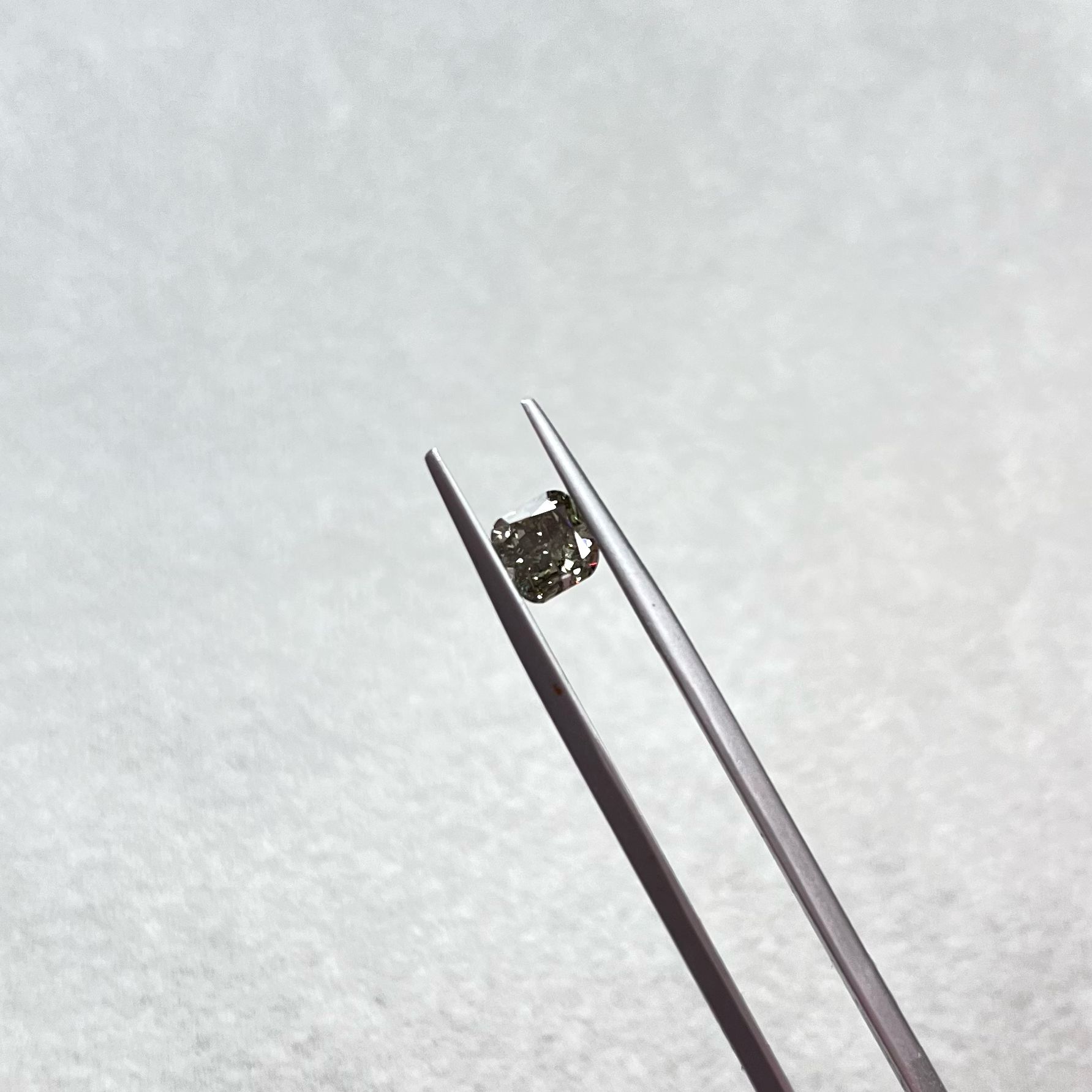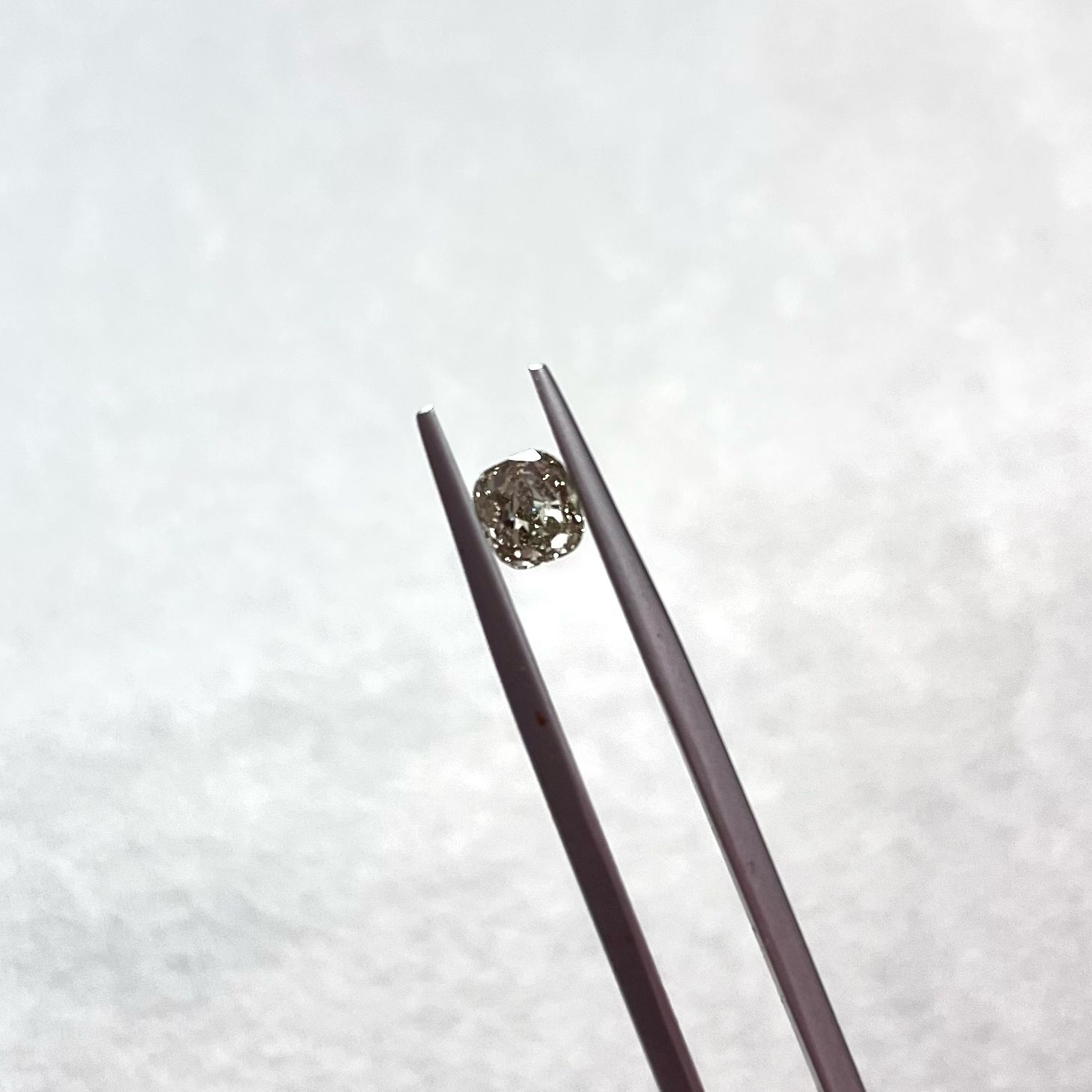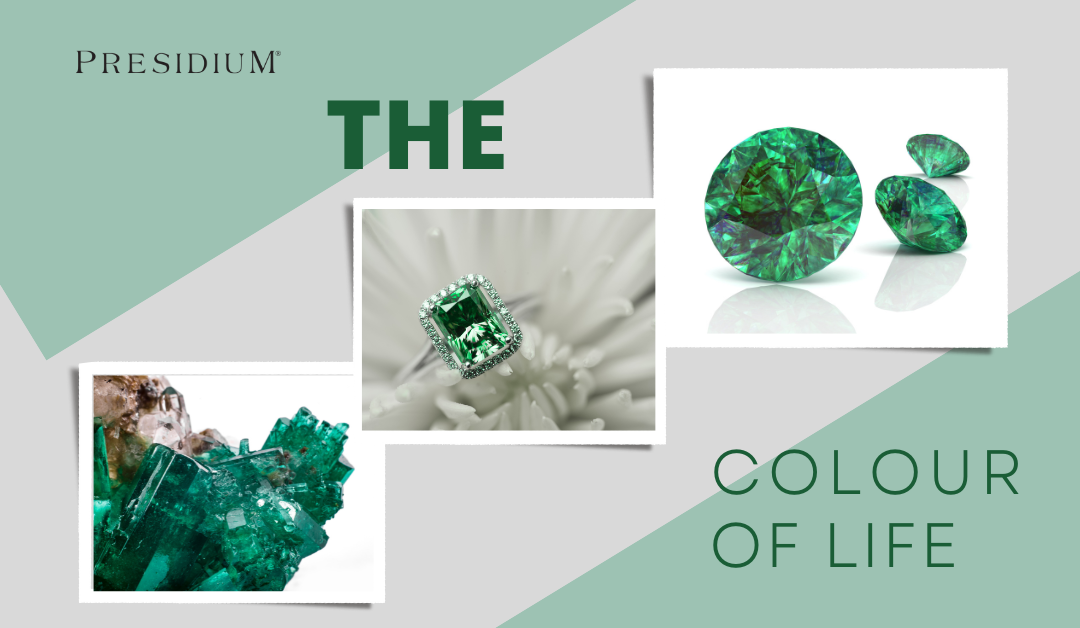
Do you feel calm or at ease when looking at plants, trees, or something green? Green is a colour that makes our planet called Earth different from all other planets. It symbolises life, nature, and freshness. It stimulates peace and brings calmness when looked upon, it is just how our eyes and brain interpret colours. Green is also ever present in the world of gemstones. It occurs in many types and varieties of gems and minerals, but more often than not, caused by the same trace element.
Here are some green gemstones seen in the market, used in jewellery, and significant to the trade and gem connoisseurs:
One of the most distinguished green gems in the market, emerald has defined the colour green in gemstones. Belonging to the mineral species of beryl (beryllium aluminium silicate), with colour-causing trace elements of either chromium or vanadium, emerald is the most well-known beryl variety followed by aquamarine and morganite.
The earliest known use of emerald was recorded during Cleopatra's reign in Ancient Egypt where she actually owns one of the earliest emerald mines of their time. In later times, more and more mines were discovered, unearthing extraordinary emerald specimens in places like Russia, Brazil, Colombia, Zambia, etc.
Among them, Colombian emerald has the highest reputation for being the best in colour and clarity. The formation of Colombian is nothing short of a geological miracle whereby rare elements of beryllium and chromium, and lower iron content contributed to its pure green colour. Thanks to hydrothermal fluids that extracts these elements from and carries through the surrounding rocks, which then redeposit them onto underground veins to be crystallised into emerald crystals.
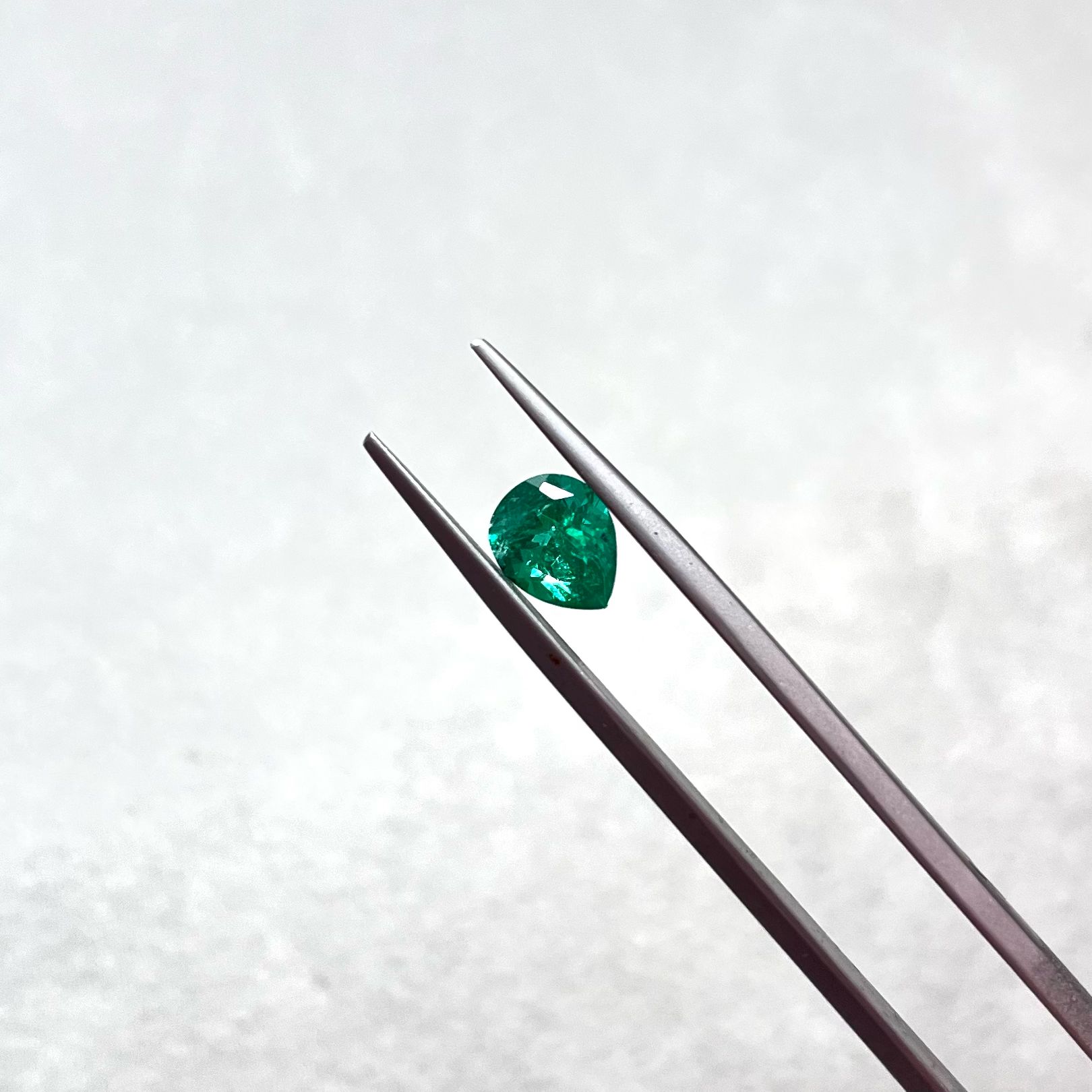 |
 |
|
1.36ct Emerald, Colombia |
0.88ct Emerald, Brazil |
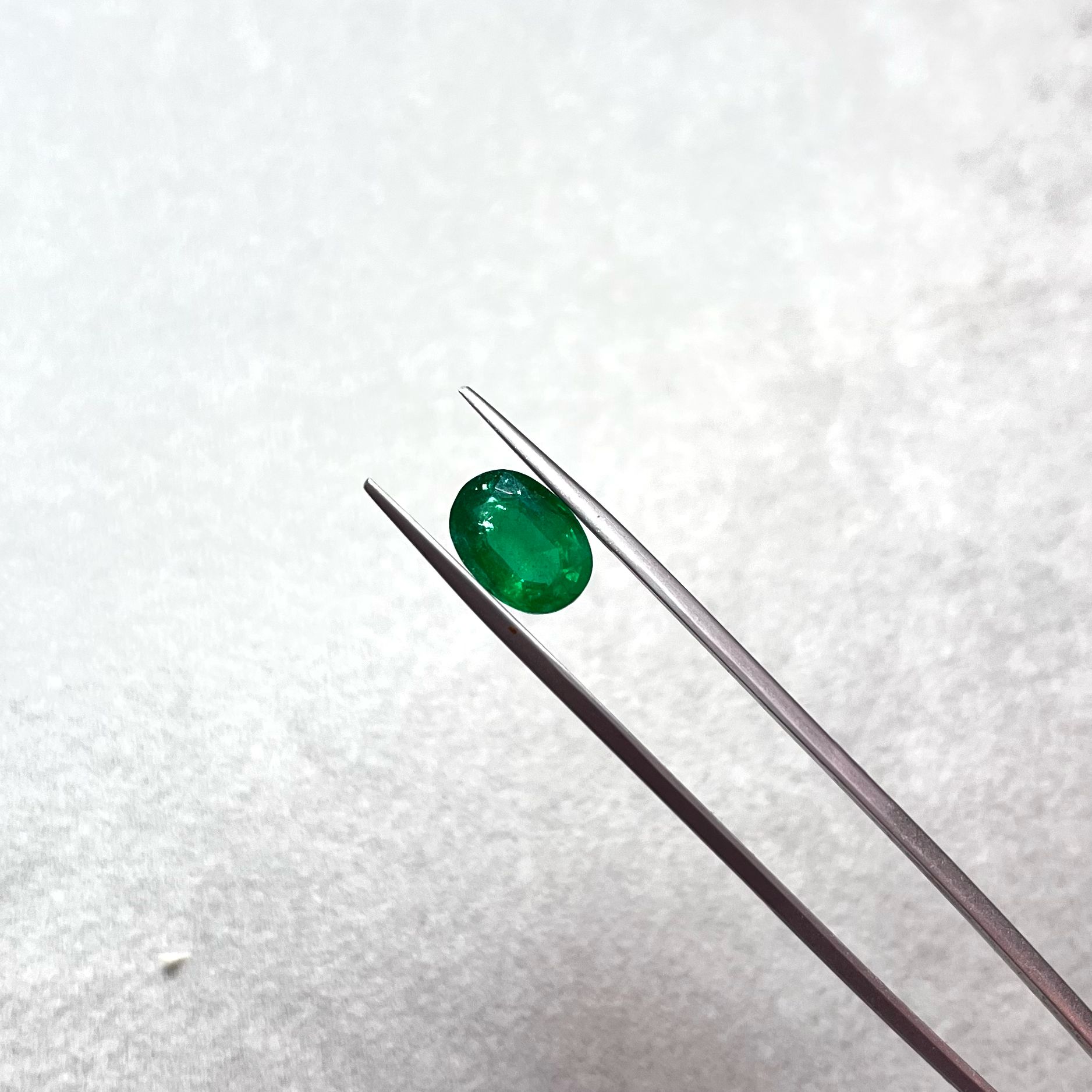 |
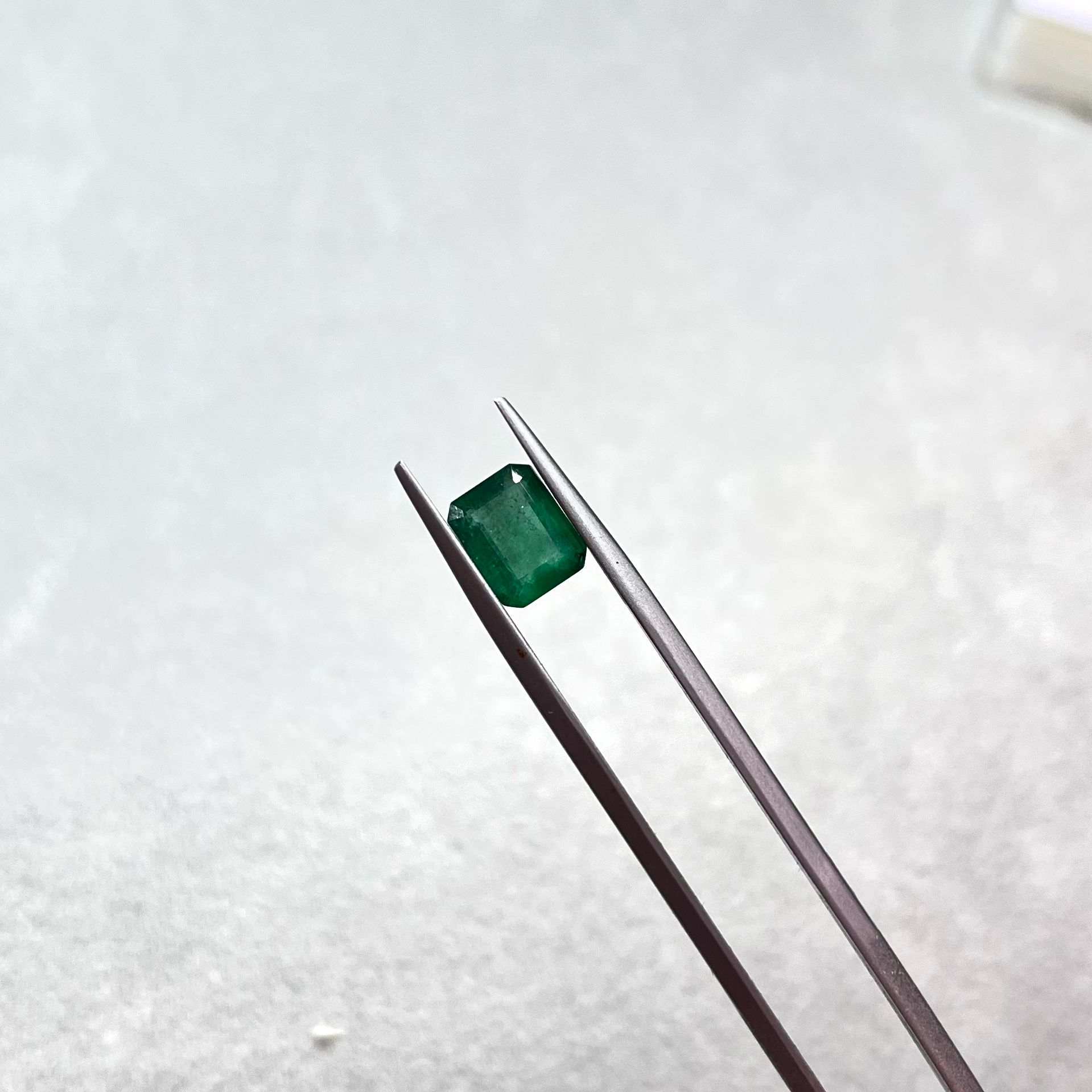 |
|
3.50ct Emerald, Origin unknown |
2.09ct Emerald, Russia |
Emerald is no stranger to inclusions, to such an extent that almost all emeralds ever discovered have eye-visible impurities. It was once described as Jardin, “garden” in French for its ever pronounced fissures and fractures. Harsh mining methods such as usage of dynamites to loosen hard rocks have been accused of causing damage to these fragile crystals. But observation in emerald synthesis in laboratories shows that there are mechanical stresses in its formation process, thus inducing fissures and fractures within it.
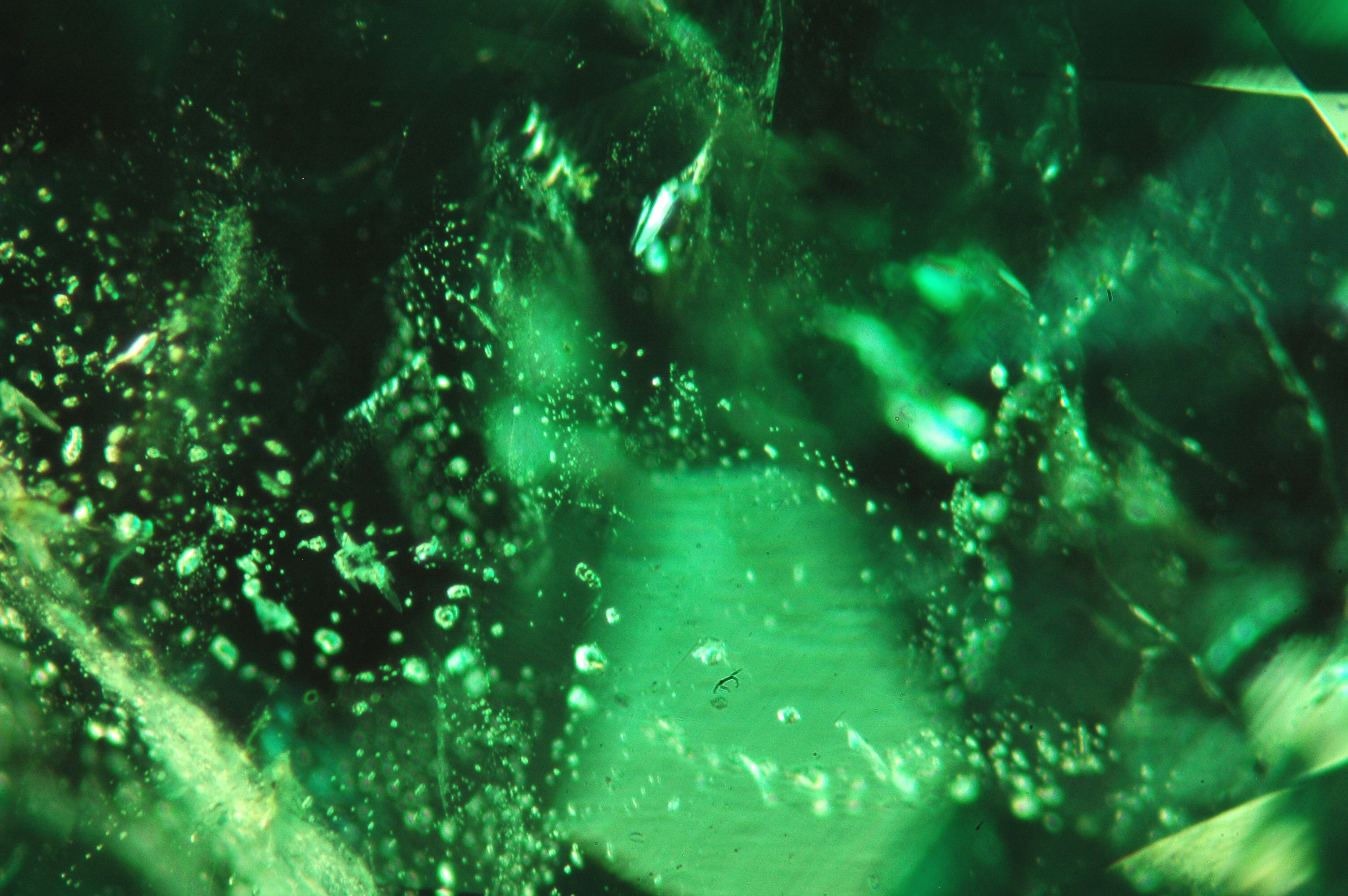 |
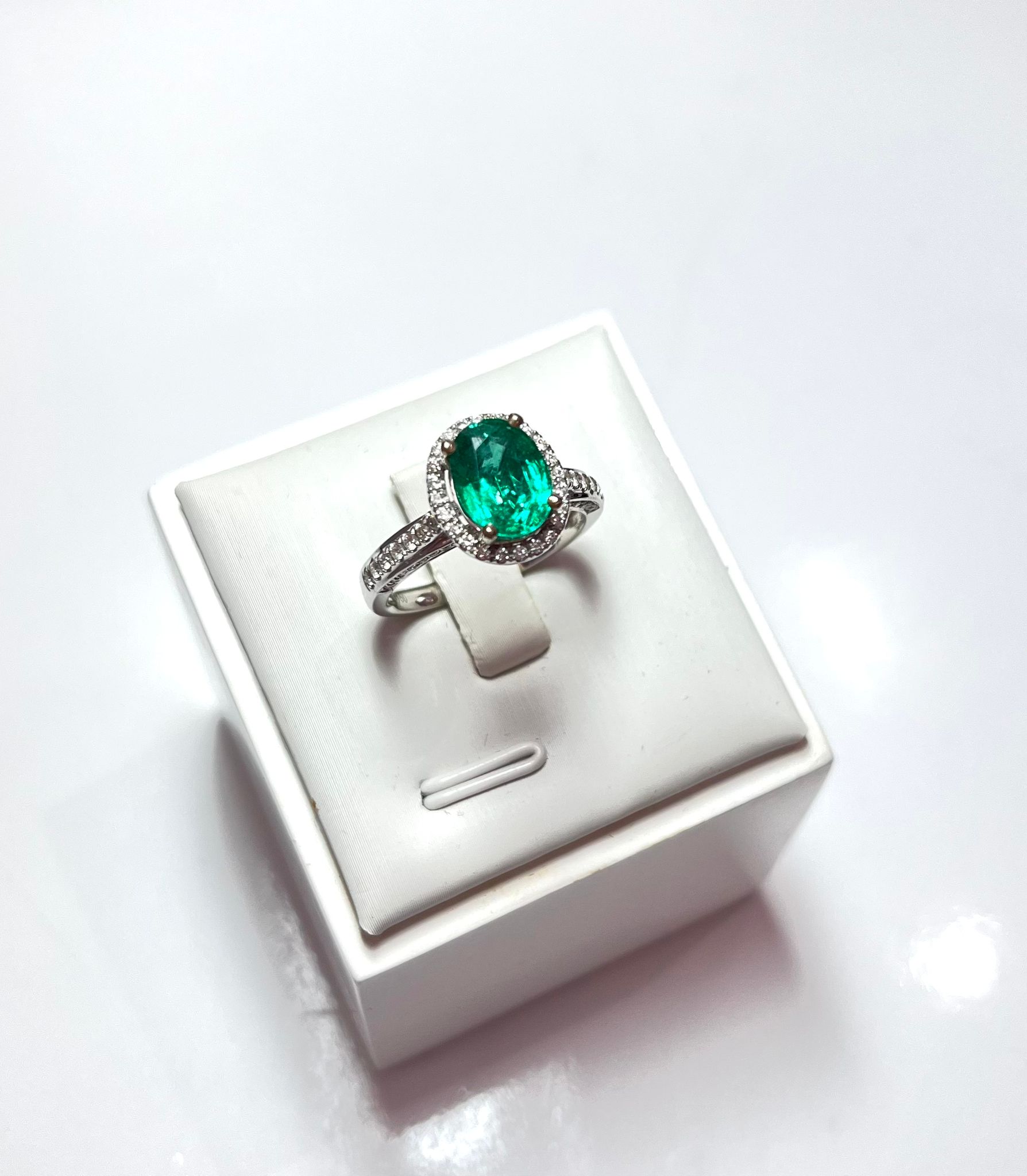 |
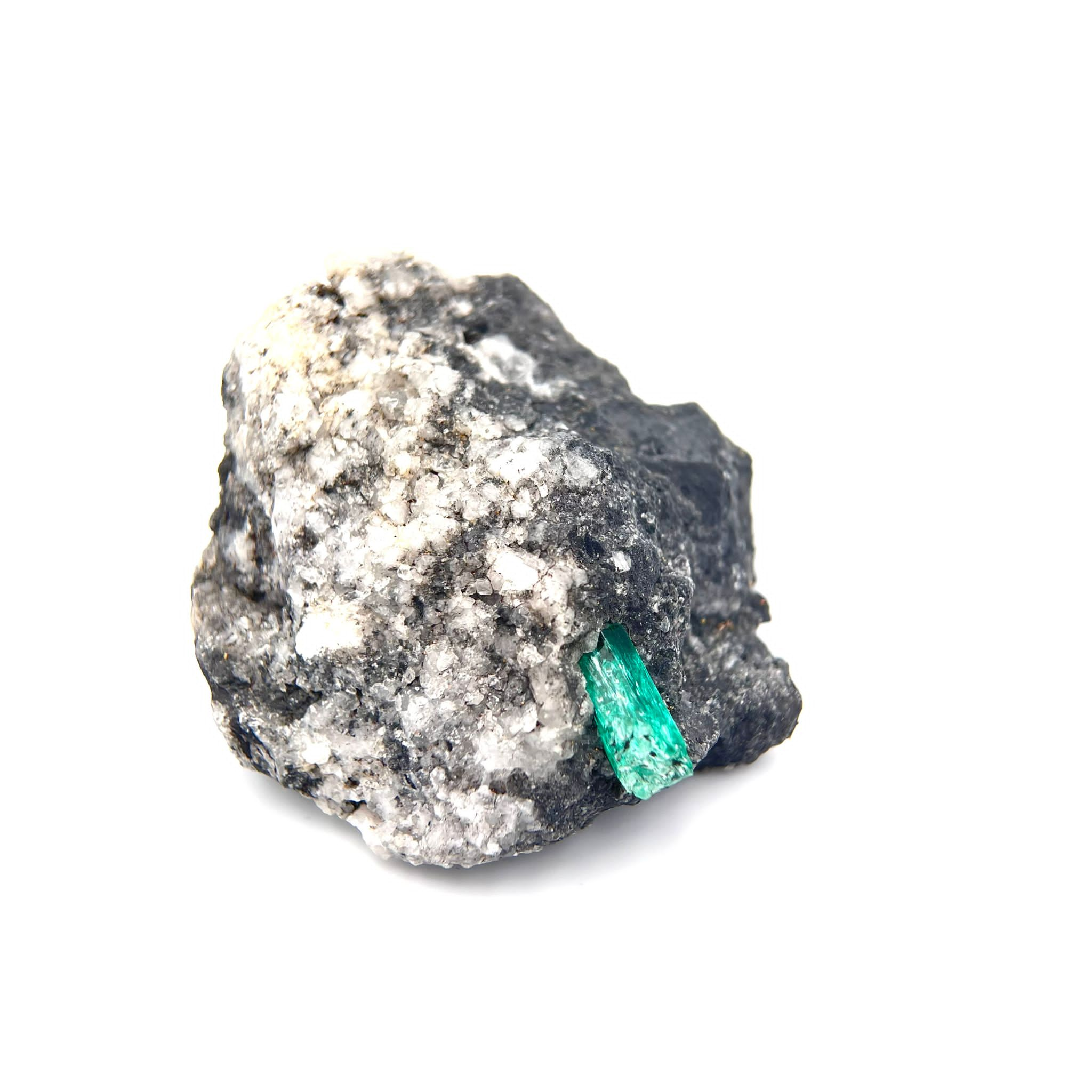 |
| Zambian emerald with 2phase inclusions and fingerprint inclusion x30 |
A 1.91 ct oval shaped emerald set in 18K white gold with diamonds. This is a classic design for a classic piece of gem. |
Rough emerald from Zambia still stuck in its matrix of quartz and schist. |
For that reason, the majority of emeralds in the market are treated with natural or synthetic colourless oil. Oiling has been widely used and accepted mainly to improve the quality of the stone, as long as it is colourless. Furthermore, oiling stabilises highly fractured crystals and stones to ensure it survives the cutting and polishing process.
Tsavorite and demantoid belong to the mineral group of garnet which consists of many species and is more widely known for its classic red varieties. Green garnets however, hold a significant place in the gems and jewellery market and those consist of tsavorite and demantoid.
Demantoid garnet has a relatively longer history compared to tsavorite. First discovered in the mid 1800s in the famous Ural Mountains, Russia. Demantoid is specifically identified as a variety of andradite garnet, and its colour ranges from pure green - caused by chromium, with sometimes yellow or brown modifiers - caused by ferric iron. What makes demantoid cut above the many other gemstones are two things: exceptional brilliance and dispersion (considered as one), and the one-of-a-kind horsetail inclusion.
Usually inclusion impures a gemstone and devalues it, like the lower clarity of a diamond the less costly it will be. On the contrary for demantoid garnet, collectors WANT the stone to have this inclusion. Horsetail inclusion can be made up from byssolite, a type of fibrous hornblende; or chrysotile, also known as white asbestos, and it is fairly rare to find a pretentious horsetail. Talking about finding the beauty in the ugly.
Alternatively, if a horsetail demantoid garnet is out of the budget, an eye-clean demantoid garnet possesses the same level of impressiveness. With good clarity, it allows light to be transmitted unobstructed to create brilliance and disperse into its spectral colour, comparable to a diamond’s.
Meanwhile in 1967, the discovery of tsavorite in a location where it was named after - Tsavo Park, Kenya, prompted businesses and connoisseurs to bring it into the spotlight because of its beauty. Although it may not have the brilliance of a demantoid, its colour, also caused by chromium with vanadium and is very on par to an emerald. If were to compare it to an emerald, undoubtedly tsavorite comes out the victor in terms of clarity. Tsavorite belongs to the variety grossular of the garnet group, and any tsavorite more than 2 carats are considered rare.
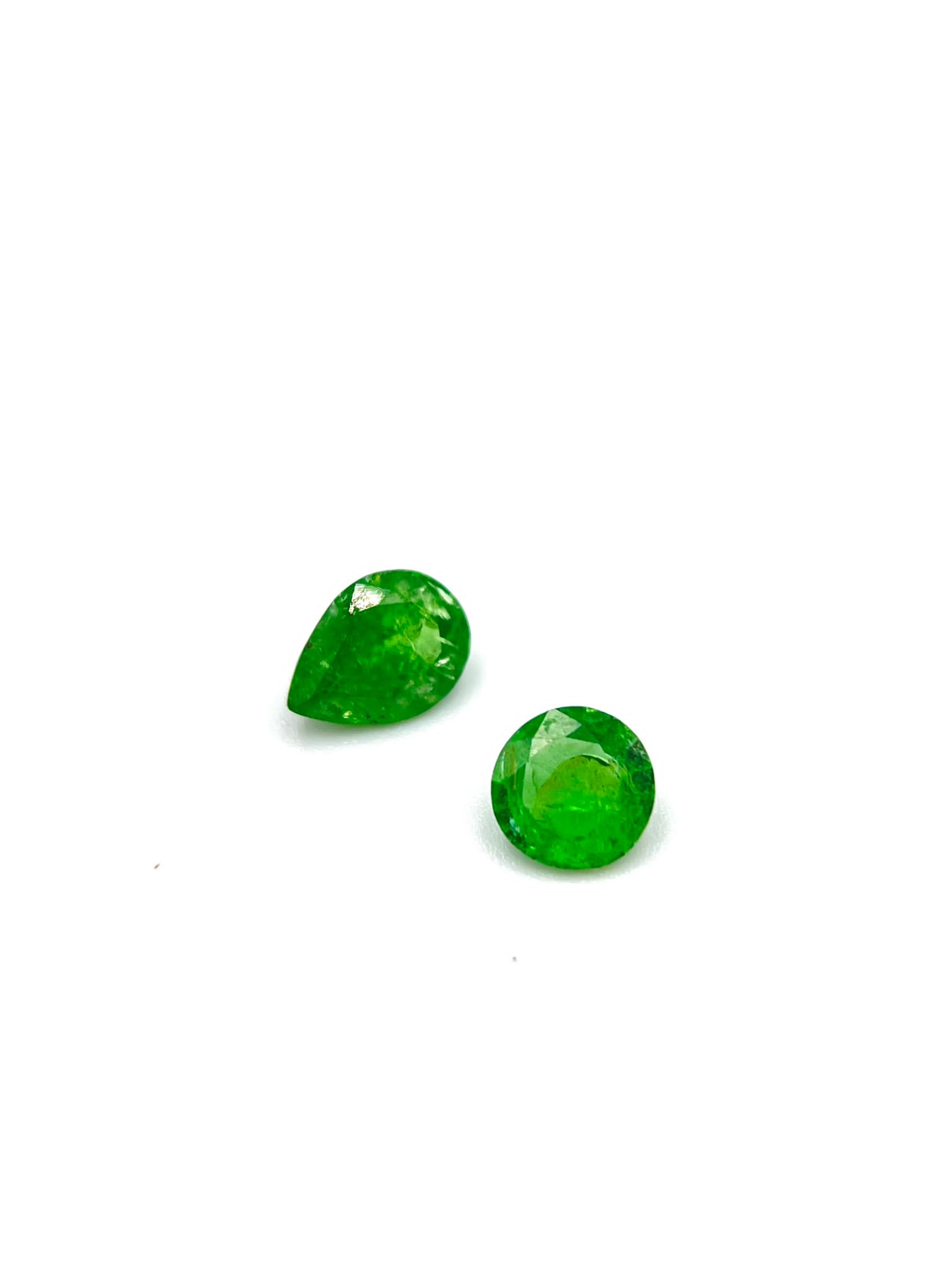 |
 |
 |
|
Two pieces of Tsavorite Garnets weighing 0.51ct and 0.34ct respectively. |
A Demantoid Garnet from Russia |
A beautiful demantoid garnet set in a classic design ring made in 18K white gold with diamonds. |
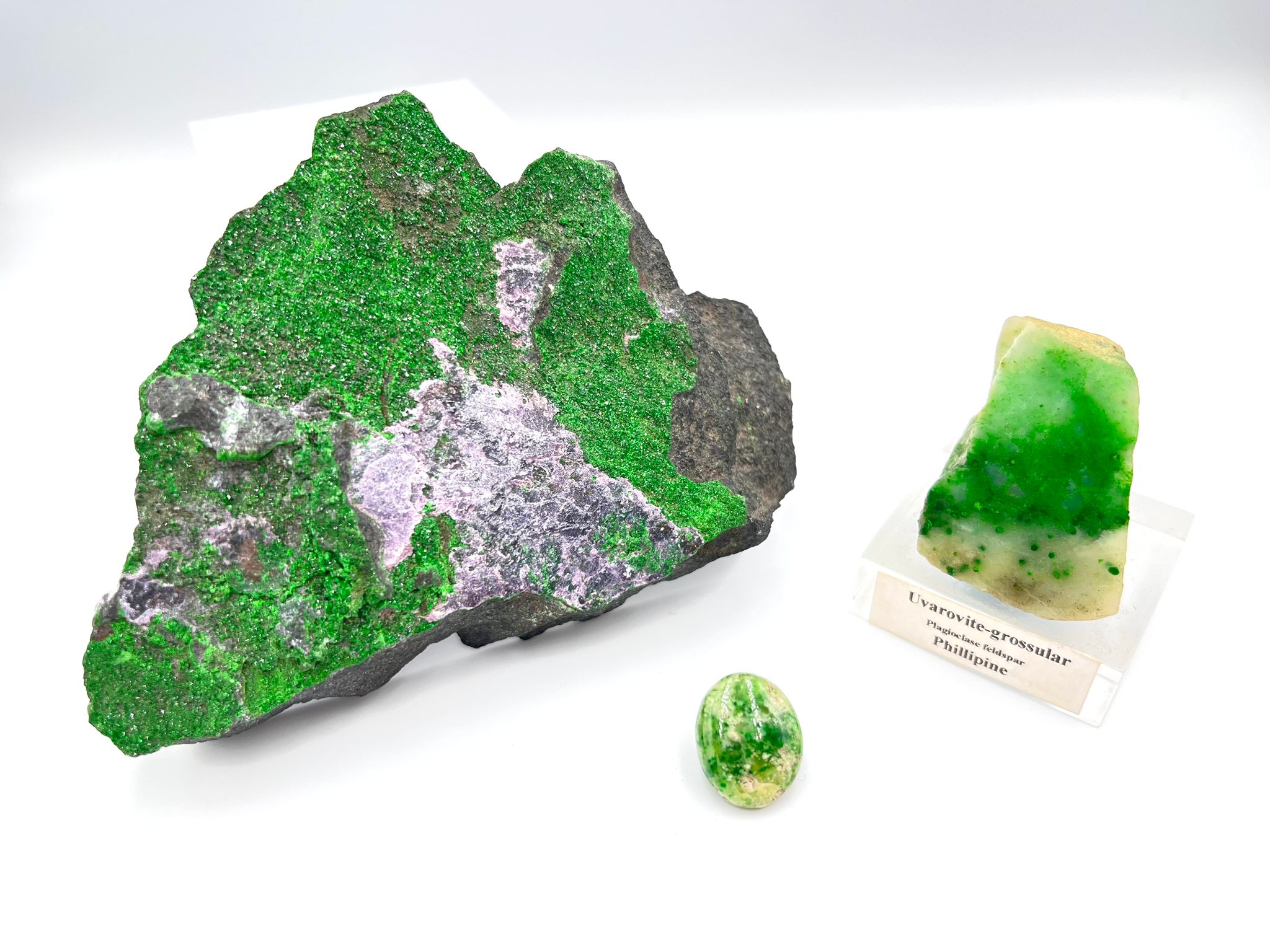 |
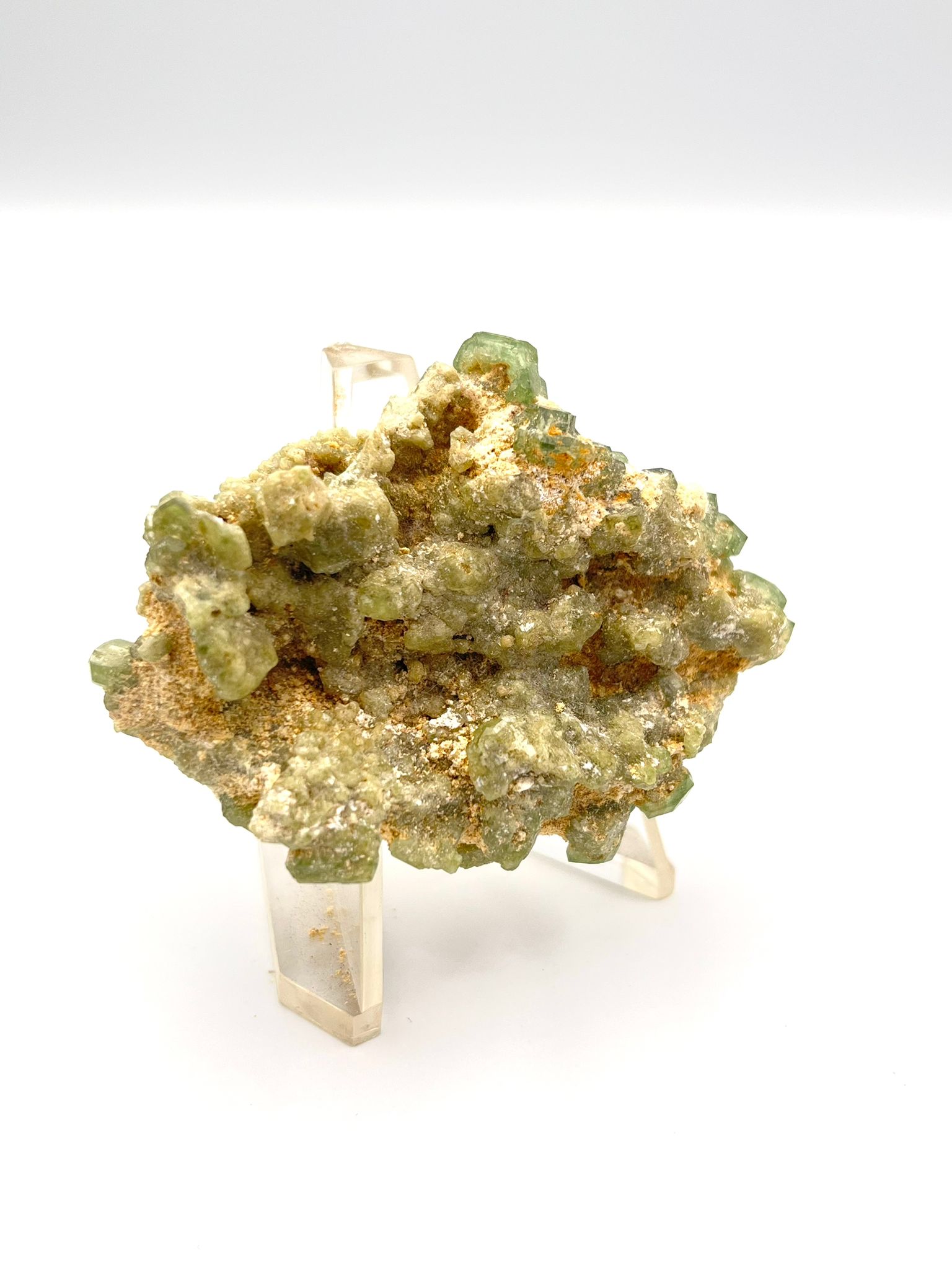 |
|
Other green garnets include uvarovite garnet that can be found in various places such as Russia and Philippines. Sometimes it may even be confused with jadeite-jade! |
This green garnet specimen from Madagascar shows a rather well grown crystal cluster. |
Tourmaline is a huge mineral group consisting of a few dozen varieties with different chemical compositions. For that reason, tourmaline makes up all possible colours in our spectrum. But for green tourmaline, the usual suspects come into mind, which are chromium and vanadium and this variety is known as chrome tourmaline. Those that are coloured by these two elements typically possess dark tones, whereby its colour is only visible under transmitted light. On the bright side, green tourmalines are typically eye-clean and enjoy the every benefit of a good polish.
As for those that are not coloured by the aforementioned elements, can be known as verdelite, or just green tourmaline. Generally these have much lighter tones, vibrant, and easier to interpret its colour. Such tone can be recognised in the trade as mint tourmaline, a green pastel coloured gem. Soothing, lovely, calming, whatever you want to call it, mint tourmaline is on the rise.
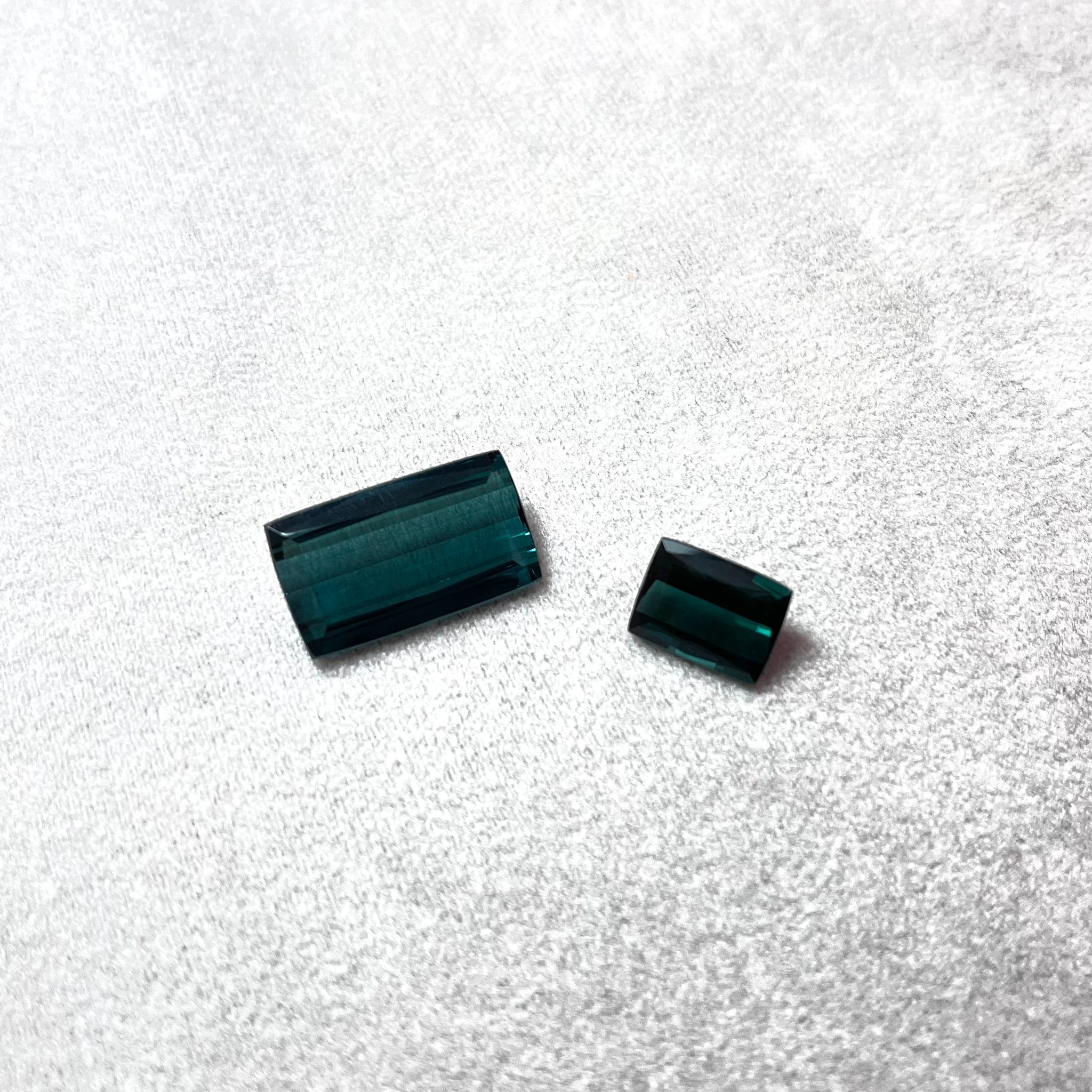 |
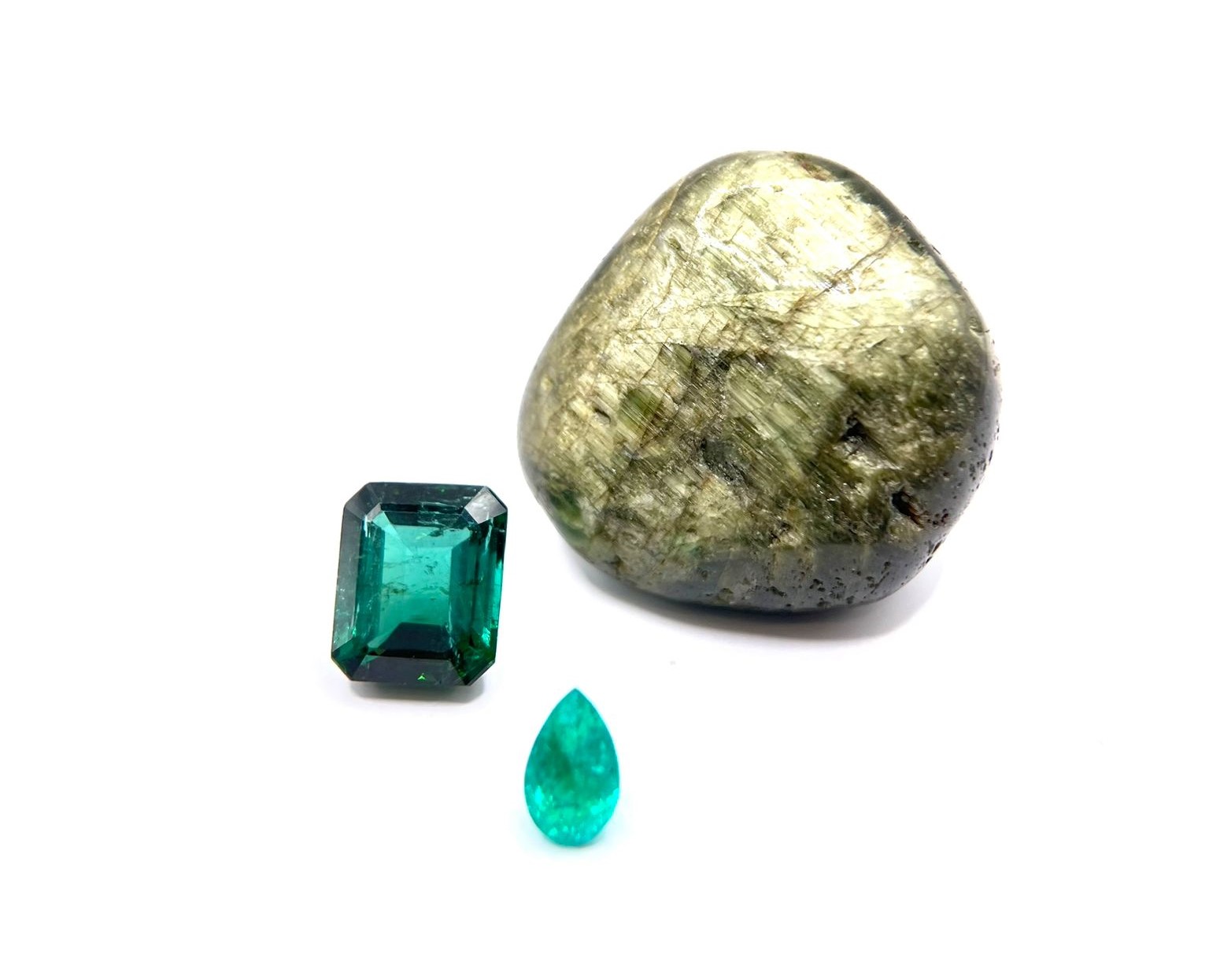 |
|
Two pieces of baguette cut indicolite tourmalines. Some people see indicolite to be more blue and some see it to be more green. It can get quite personal. |
Front to back: Mint green tourmaline, 7.21ct green tourmaline, cat’s-eye tourmaline |
Cat-eye Tourmaline
As we all may know by now, sapphire comes in all colours except for red. Some colours tend to be more well received than others, for example, blue, yellow, pink, purple. Green sapphire however, may not be as popular due to its colour being rarely pure or vivid hence the low demand and value. Regardless of what is being said, some green sapphires can look amazing. Dark toned hue paired with reflective lustre, 9 on the Mohs hardness scale, affordable, and one of the big four precious gemstones are all qualities one can ask for.
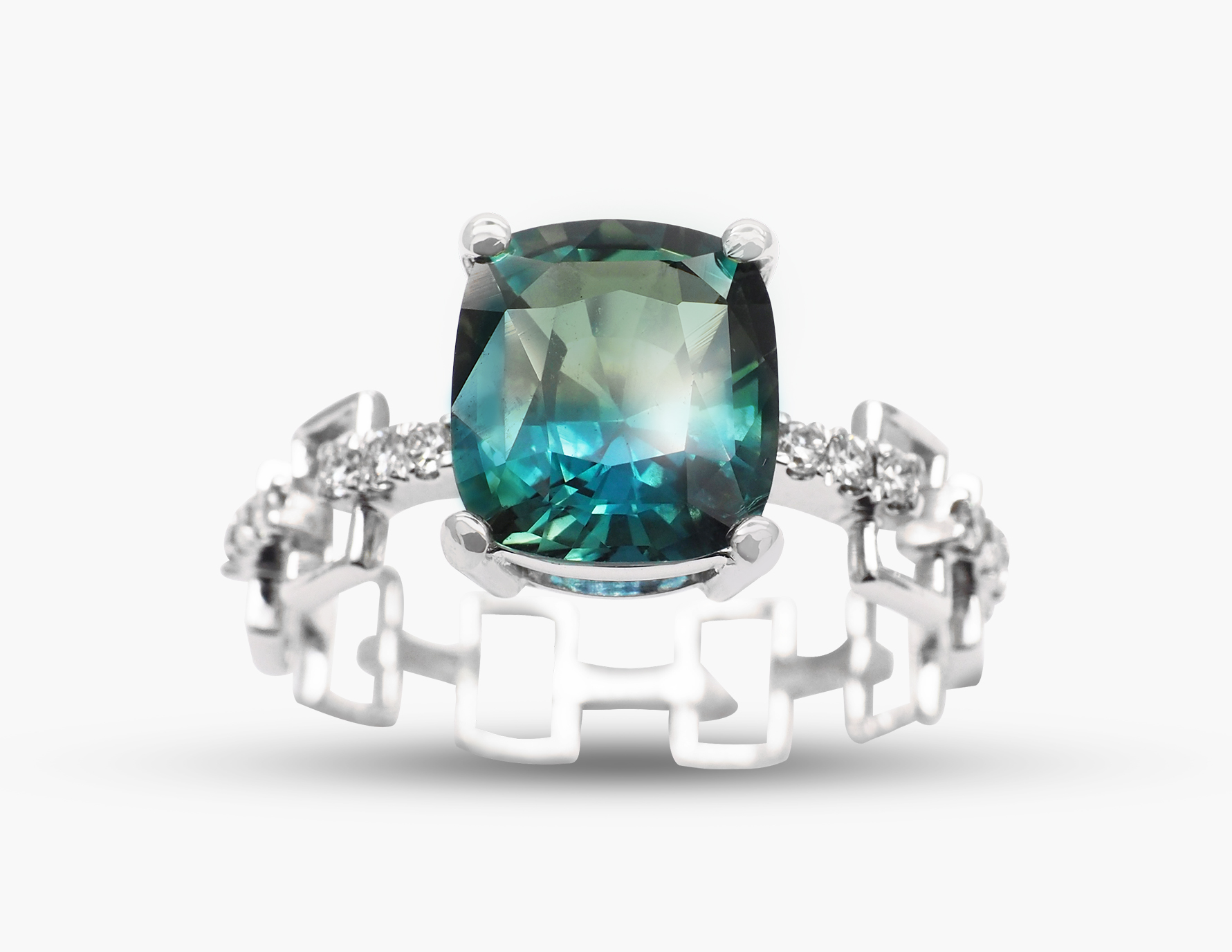 |
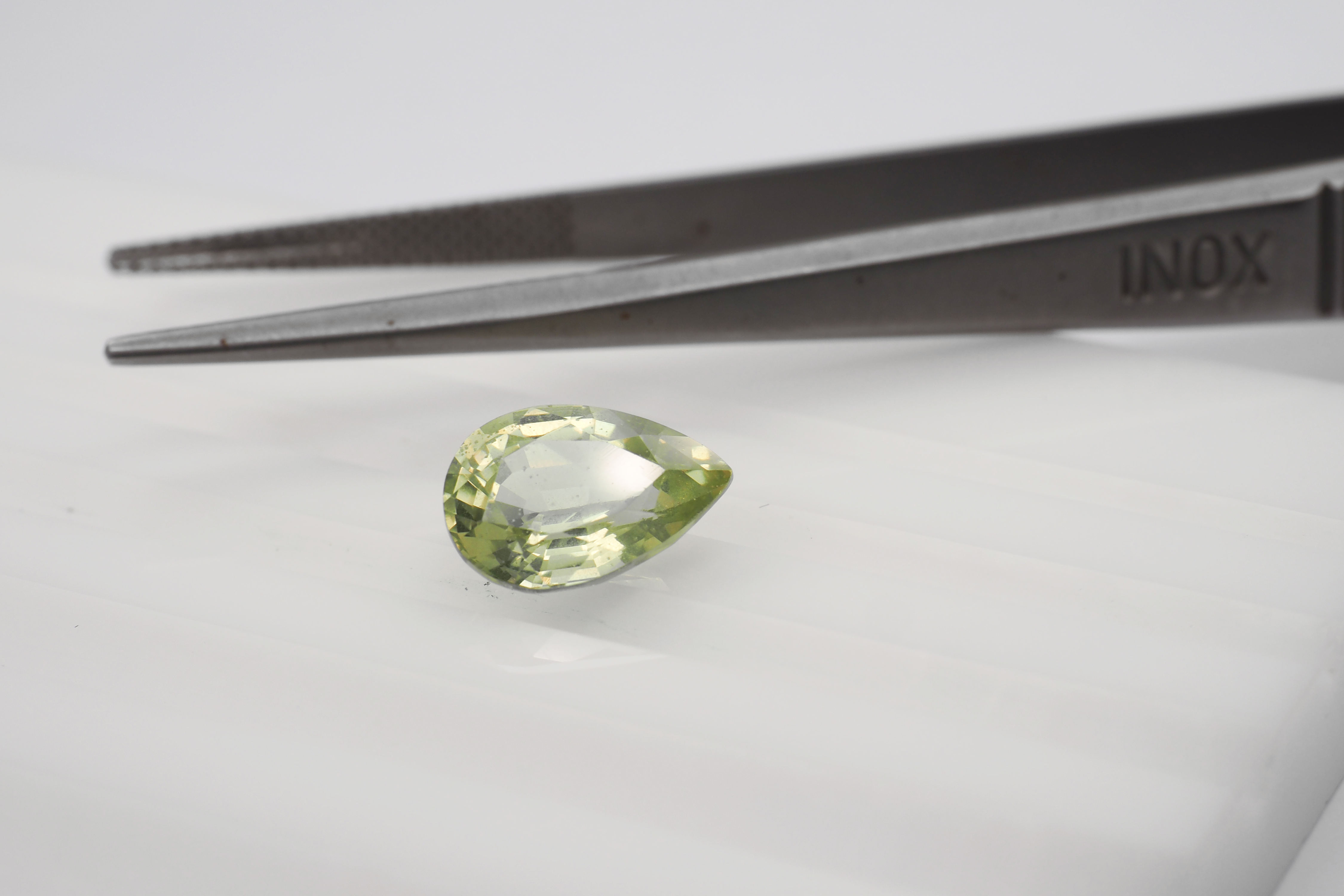 |
|
A 4.44ct green sapphire set in a unique design ring. |
This 2.83ct unheated sapphire has a light green tinge to the colour. |
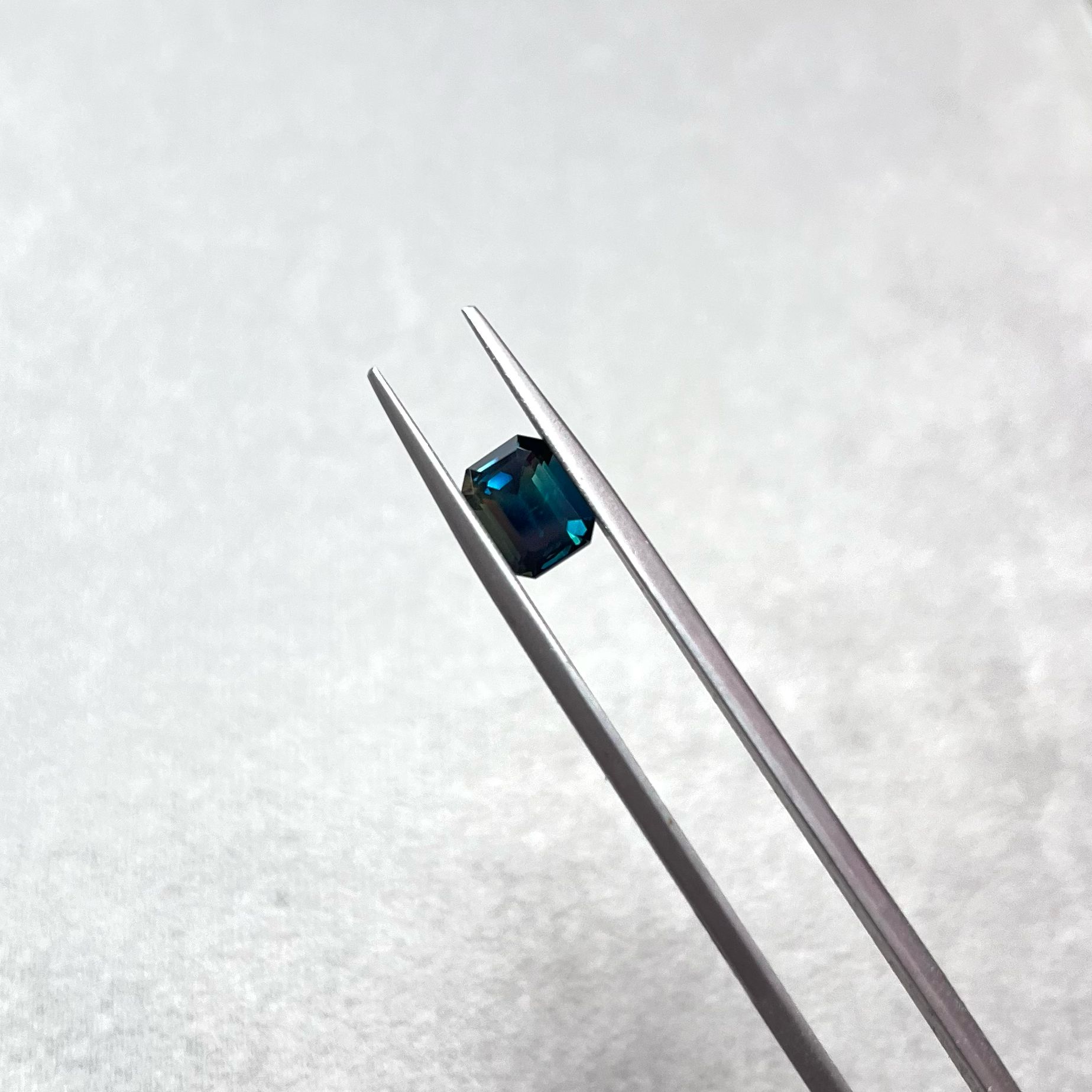 |
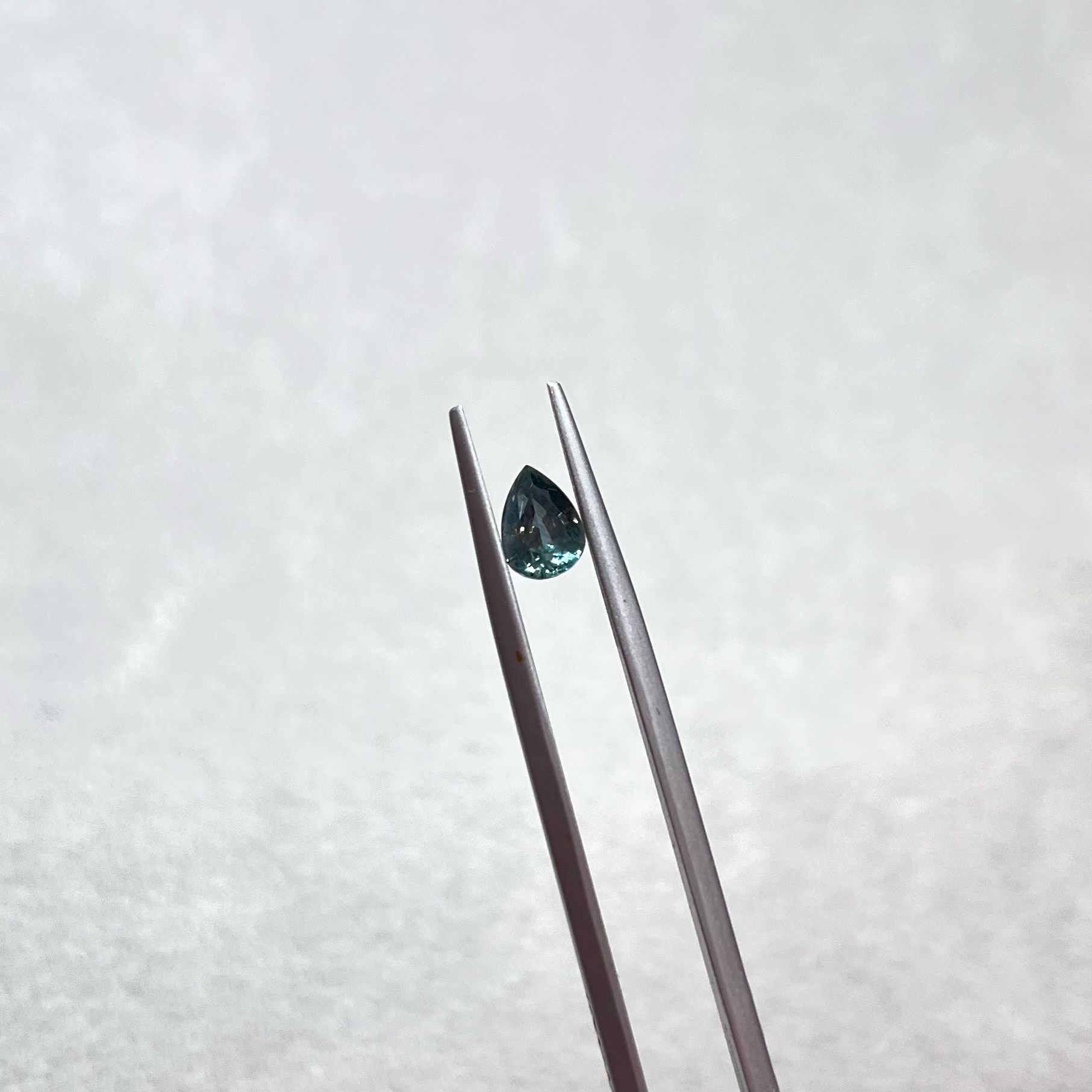 |
| A 2.29ct emerald cut Teal sapphire. Teal sapphires became very popular in the last few years |
A 1.07ct unheated montana sapphire, showing a slight tinge of blue. |
Peridot is one of the very minerals/gemstones that can form in outer space, best known as olivine in the mineral stage. As for peridot, it has a history as far back as the emerald, and it is one of the two gemstones in this list that is an idiochromatic gem. By idiochromatic meaning a stone is “self-coloured” by its own chemical composition, thus it displays a very consistent hue, tone, and saturation. Although it has its consistency, peridot rarely comes in a pure green hue. It often displays a yellowish-green shade, almost like a fresh olive.
 |
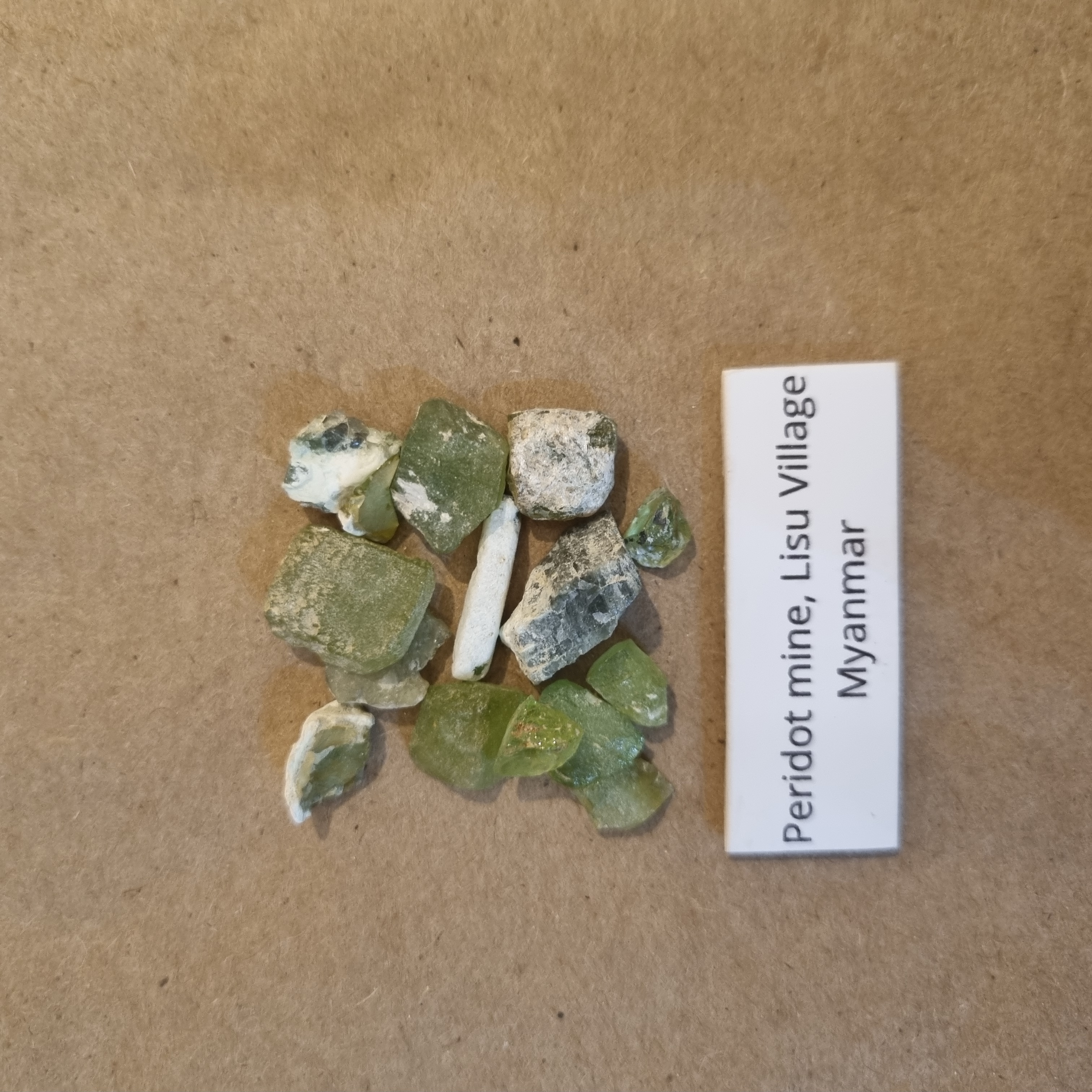 |
|
A picture of workers working at a peridot mine in Myanmar, Lisu Village. |
These are some rough peridot mined at the peridot mine. |
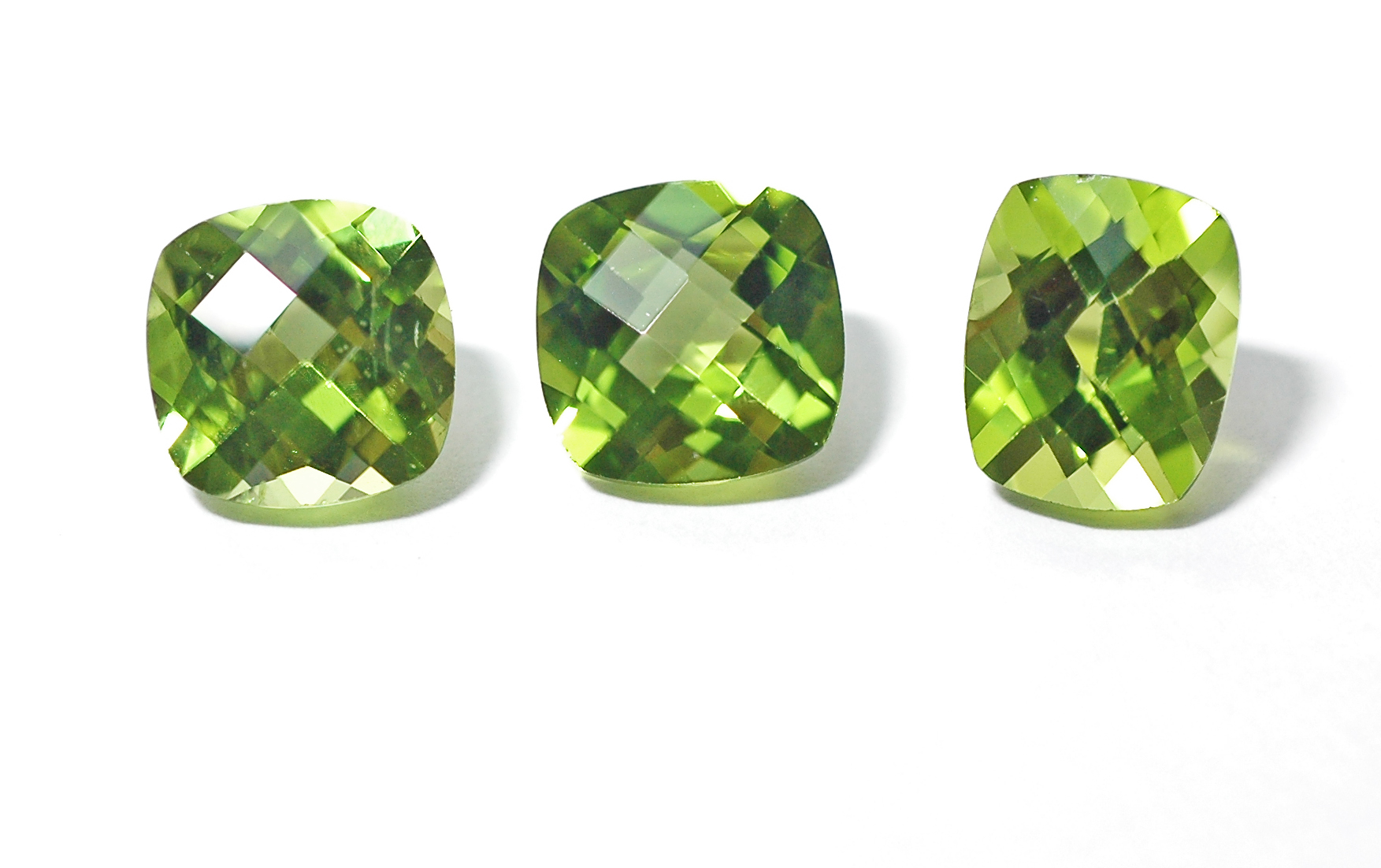 |
 |
|
3 pieces of pixel cut peridot from China. |
Lily-pad inclusions that are typical to peridots. |
Zircon can be magnificent, surprisingly underrated, and it is one of the December birthstones along with turquoise and tanzanite. Available in many colours, but what makes green zircon stands out in this list is its colour origin. Majority of minerals and gemstones obtain their colour from trace elements in a stone’s crystal lattice, green zircon however, gets radiated from radioactive elements such as uranium and thorium. Do not be alarmed, the radiation emitted by these elements is barely measurable hence is harmless to humans, but not for the stone. By hosting these elements, its minute radiation slowly consumes zircon’s crystal structure that eventually becomes amorphous, or structureless. These kinds of zircon are known as metamict or low zircons. Medium zircon has slight damage, whereas high zircon has little to no damage and possesses its original gem properties like brilliance, dispersion, and high RI.
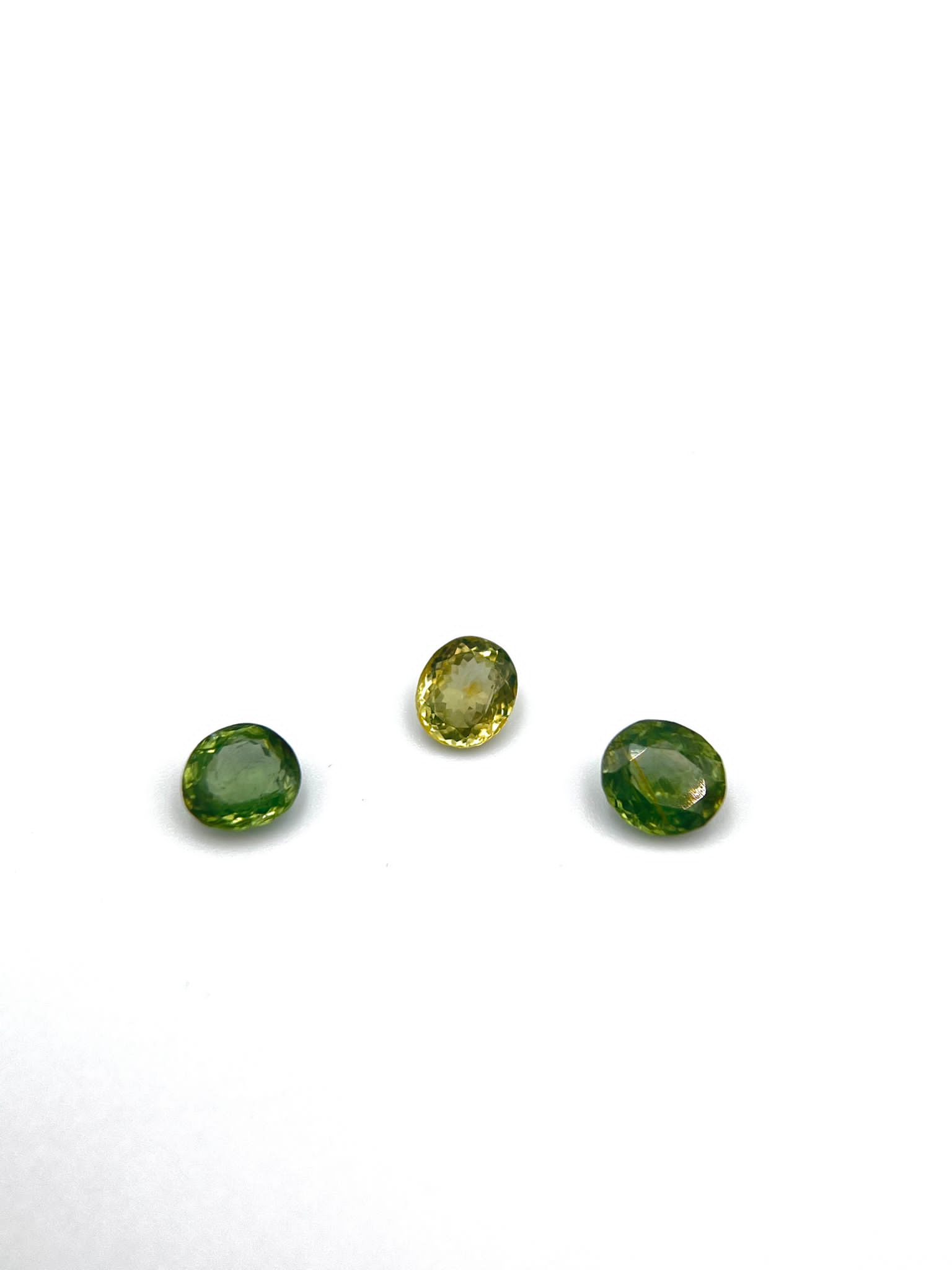 |
|
Three pieces of green zircons. From Left to right: 0.93ct, 0.92ct, 1.27ct. |
Arguably the most significant gemstone in Chinese culture, jade has been idolised since the China dynasty periods. They are popular ornamental materials, and fashioned into accessories that help identify a person’s status, rank, and wealth. Jade, is in fact a general name for two different minerals - jadeite, and nephrite. Little did people know that all ancient chinese jade artifacts are indeed nephrite, until the discovery of Burmese jadeite in the late 1700s during the Qing Dynasty.
Nephrite, the first known jade, is chemically abundant in calcium and magnesium and closely related to the tremolite-actinolite series in the amphibole group. While jadeite belonged to the pyroxene mineral group which contains sodium and aluminium. Characteristically, jadeite is slightly harder than nephrite which makes it more suitable to be worn in rings, but the latter is slightly tougher than the former. As both are extremely resistant to breakage, it makes them a carver’s favourite material.
As nephrite was excessively mined in ancient China, it is still widely available due to its abundance in nature. Canada, Taiwan, New Zealand, Russia are all known to produce nephrites and sometimes in tons of singular boulders. While it may not be as vivid green or have the large colour range of jadeites, nephrite occasionally presents itself in a slightly desaturated green, at times with yellowish tint.
Meanwhile, jadeite is rare and even so, high grade jadeite is even rarer. The definition of high grade is not only contributed by its colour, it has to combine with good translucency, and texture of the stone. Green has the highest demand in jadeite. As for the best colour grade, it is a vivid green, saturated, moderately toned - known as the “Imperial Jade”. Then again, without the right transparency it is automatically disqualified to bear the Imperial name. It requires medium translucency, just enough to allow light to transmit and scatter in the stone. This light action never fails to give admirers a stunt in awe. Lastly, various forms of grain textures in jadeite, contributed to its fine, medium, or coarse texture. All which may feel differently on different wearers, in other words, personal preference. Therefore, to find a piece that possesses all three attributes is extremely difficult, and it is only a matter of time when it becomes one of the precious gemstones.
.jpg) |
.jpg) |
.JPG) |
| A 6.60ct oval cabochon Type A Jadeite-jade of a glassy green colour |
A 34.63ct oval cabochon Type A Jadeite-jade of an apple green colour. |
An example of jadeite boulders on sale at an auction in the Myanmar Emporium in 2008. |
.jpg) |
.png) |
.jpg) |
| Nephrite-jade beads showing chrome spots |
A rectangular piece of nephrite-jade showing fibrous grain texture. |
Three round slices of nephrite-jade most likely cut to place in watches. |
Both of these gems are silica dioxide and the second most abundant mineral in the world. Although similar, its distinguishing factor is their crystal size - macrocrystalline and microcrystalline/cryptocrystalline. Macrocrystalline is quartz that forms in visible crystals and crystal habit as a terminated 6-sided pyramidal prism. As for micro/cryptocrystalline, they form without a crystal habit and also in a microscopic crystal structure, barely visible to the eye alone.
Prasiolite
Generally green quartz crystal with a trade name of prasiolite, but infamously known as green amethyst. Green quartz in nature is a rare occurrence, therefore the trade typically heats amethyst into green and hence “green amethyst”. Even so, this treatment does not necessarily produce green as it ended up with citrine most of the time. Prasiolite’s colour usually is on the low saturation spectrum.
Aventurine Quartz
Aventurine is a green translucent quartz, but mainly quartzite. Colours may have different shades depending on the amount of inclusion of chromium-rich fuchsite. In fact, just a few percent of fuchsite would be able to produce its green colour. More of those physical inclusions will create a sheen of aventurescence. Widely used and collected as tumbled pieces.
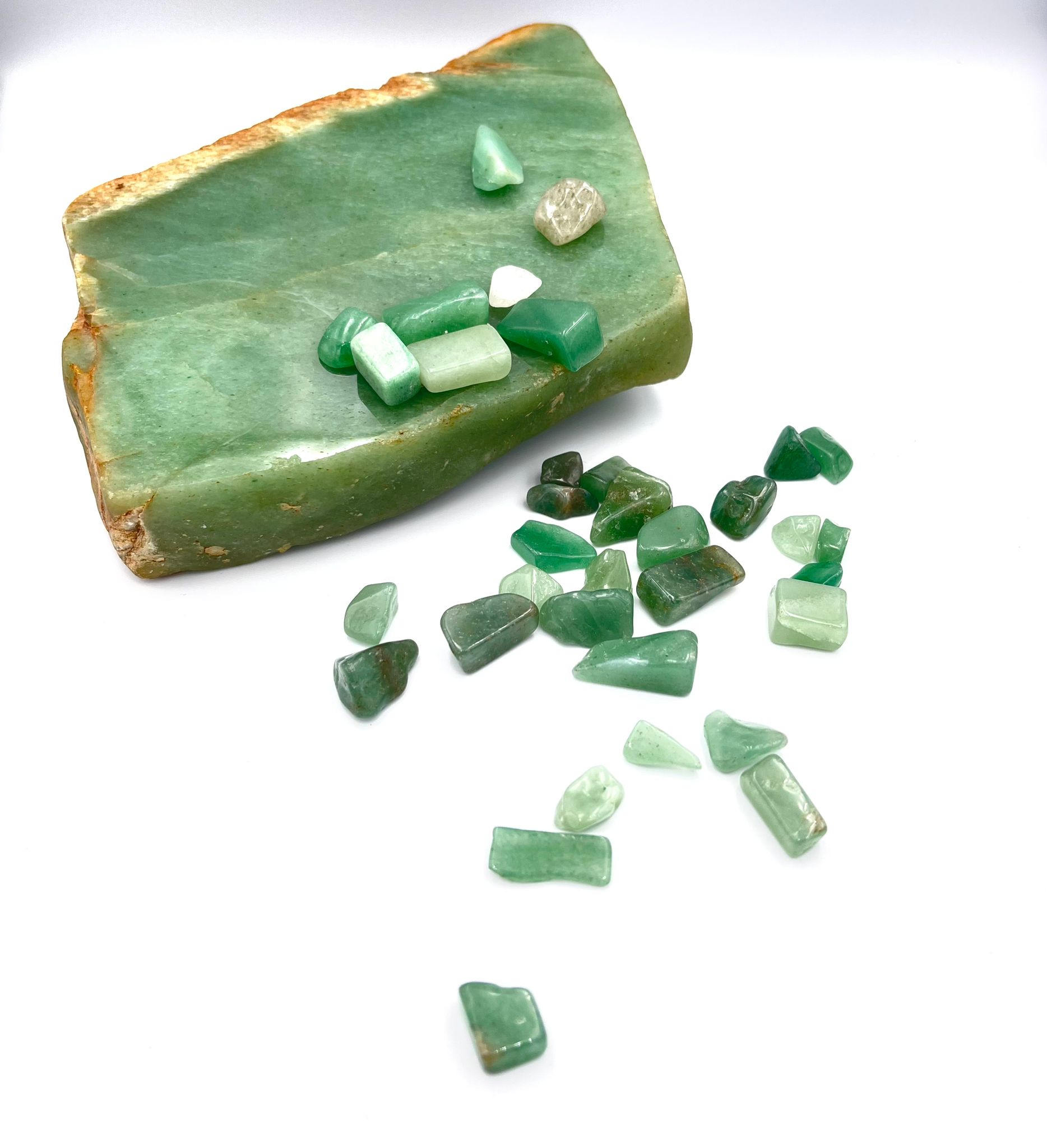 |
|
Aventurine quartz is a polycrystalline gem material that is found in large masses. |
Chrysoprase/Prase
A type of chalcedony, translucent, and also comes in various shades of green from apple, olive, to pure green. Chrysoprase contains the presence of nickel and sometimes chromium, whereas prase has the presence of chlorite inclusions as its colour source. Both have no cleavage and have the same hardness to crystal quartz of 7 that makes it an excellent gem for any type of jewelleries and carvings.
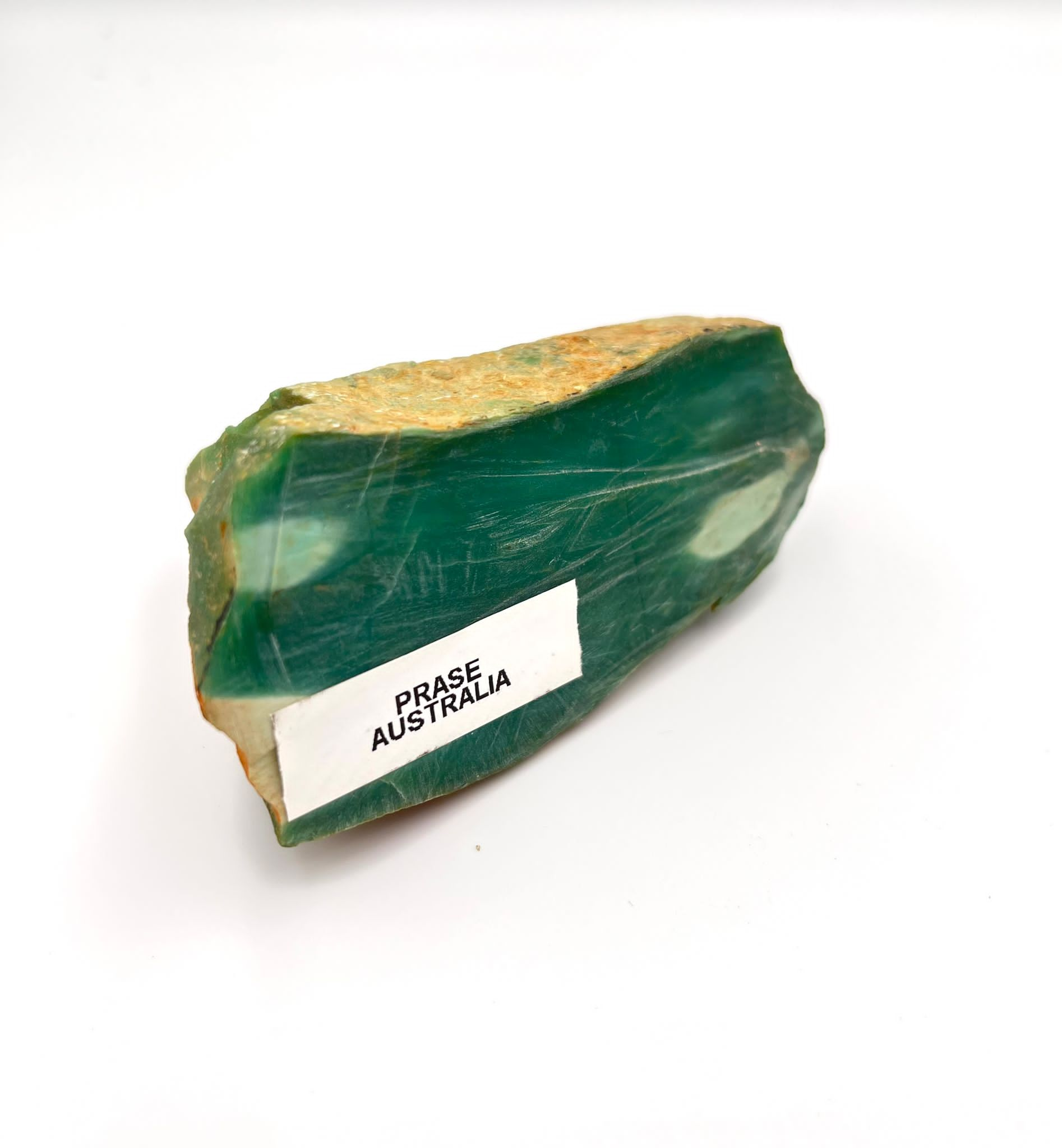 |
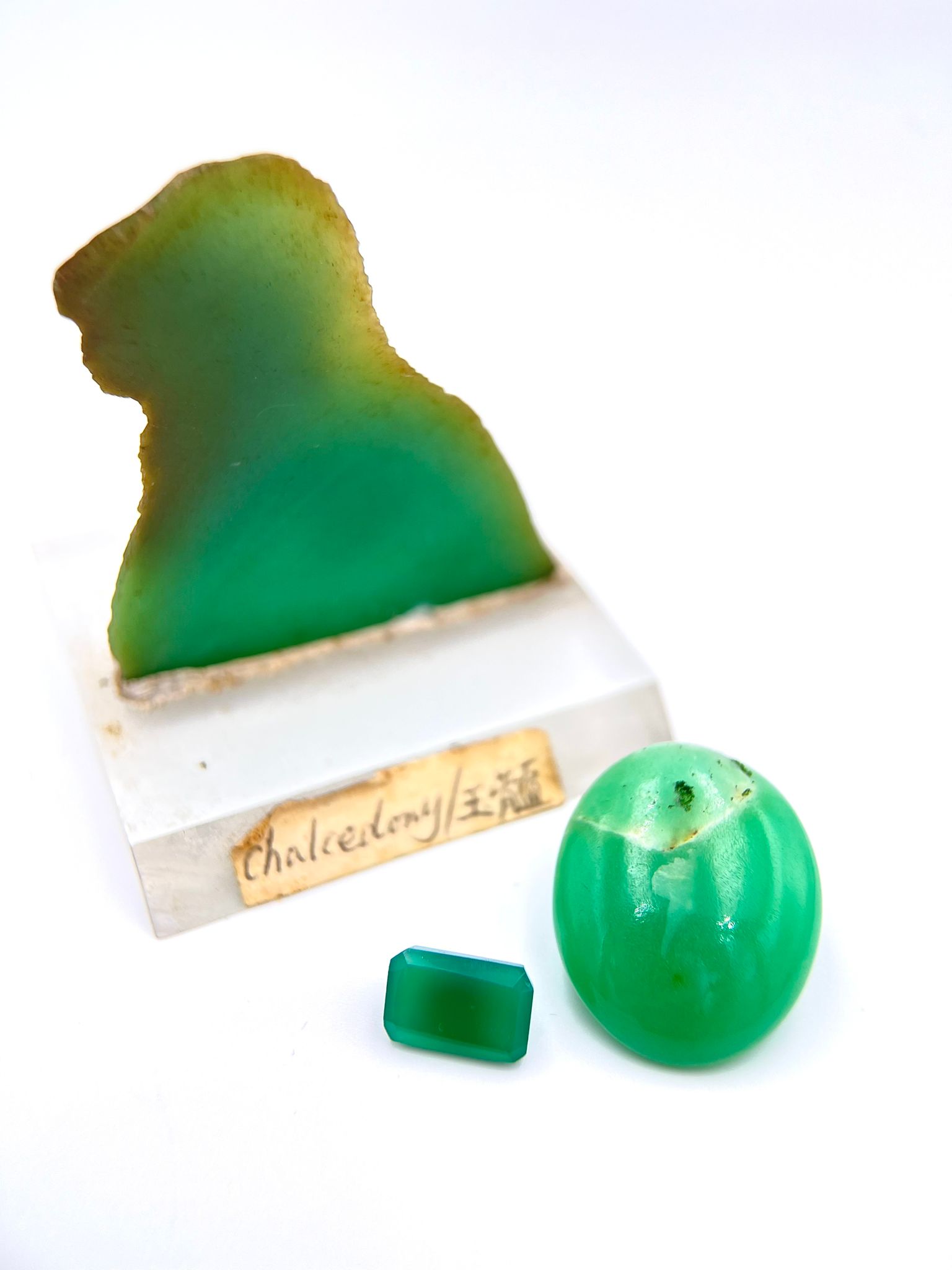 |
| Prase from Australia |
Chrysoprase is green chalcedony that has a misnomer “Australian Jade”. |
Gem Silica
This material hands down the most precious of all chalcedonies. It has a sweet and delightful bluish-green or greenish-blue colour caused by the presence of chrysocolla, or copper which lead to some calling it chrysocolla-in-chalcedony. It can be very expensive not just for its good looks, but also because it is very rare, production has been highly unpredictable so therefore rarely seen in jewellery.
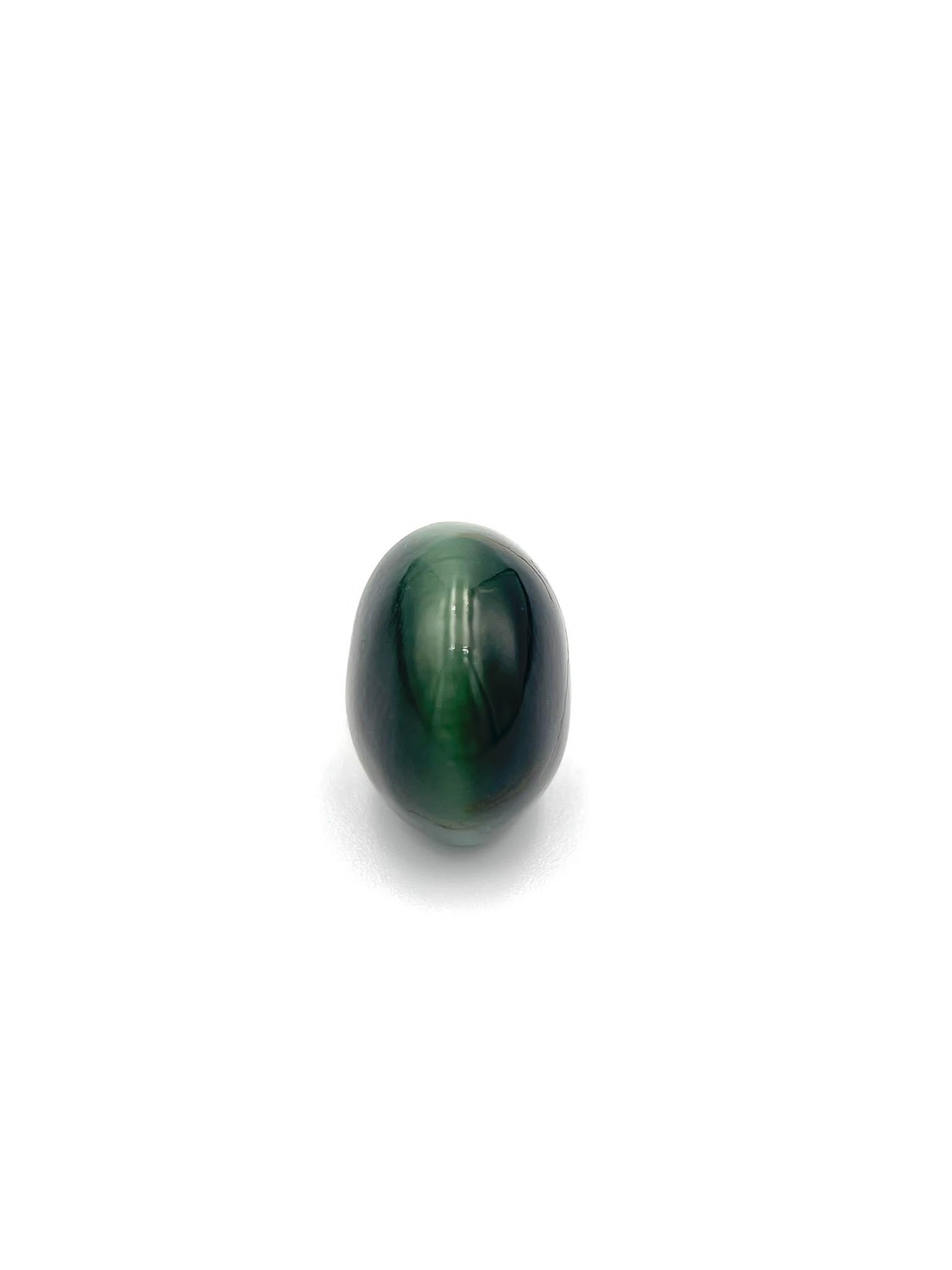 |
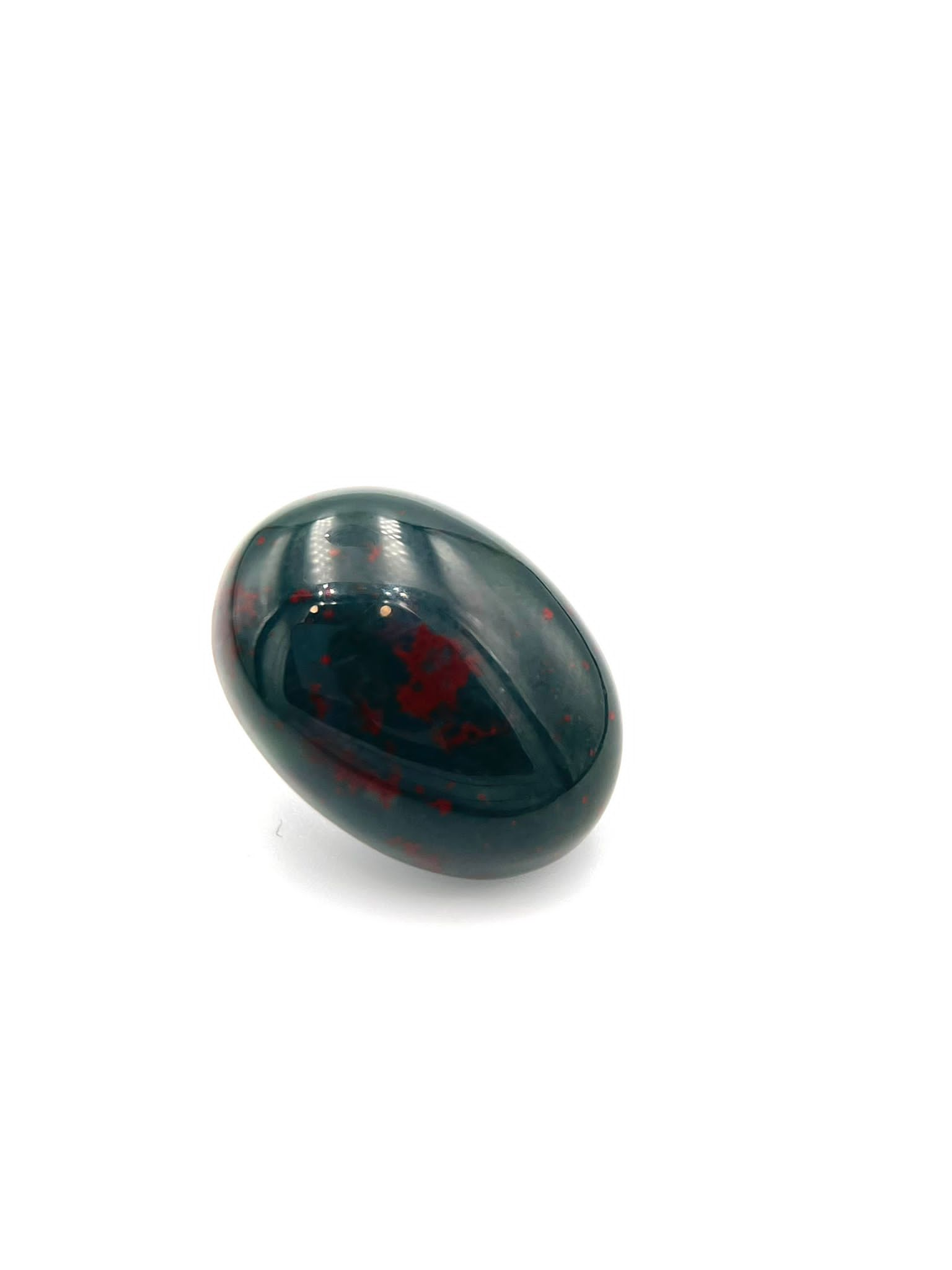 |
 |
|
A 7.36ct green cat’s eye quartz. |
8.94ct bloodstone. This is a green jasper with spots of red jasper. Coloring element is due to iron. |
An unusual piece of dendritic quartz that can make the gem material look green. |
Another “self-coloured” mineral in this list is malachite. Rather well-known in the market for its distinctive and alternating bandings, it is a hydrous copper mineral coloured by copper. Mainly opaque, but it made its mark in the market for its intense inner green. Only when polished where the malachite shows its beauty, curved bandings alternating in saturations and tones of green. Albeit being soft at 3.5 on the Mohs hardness scale, it is still a popular gem for beadings as they are not very costly and widely available.
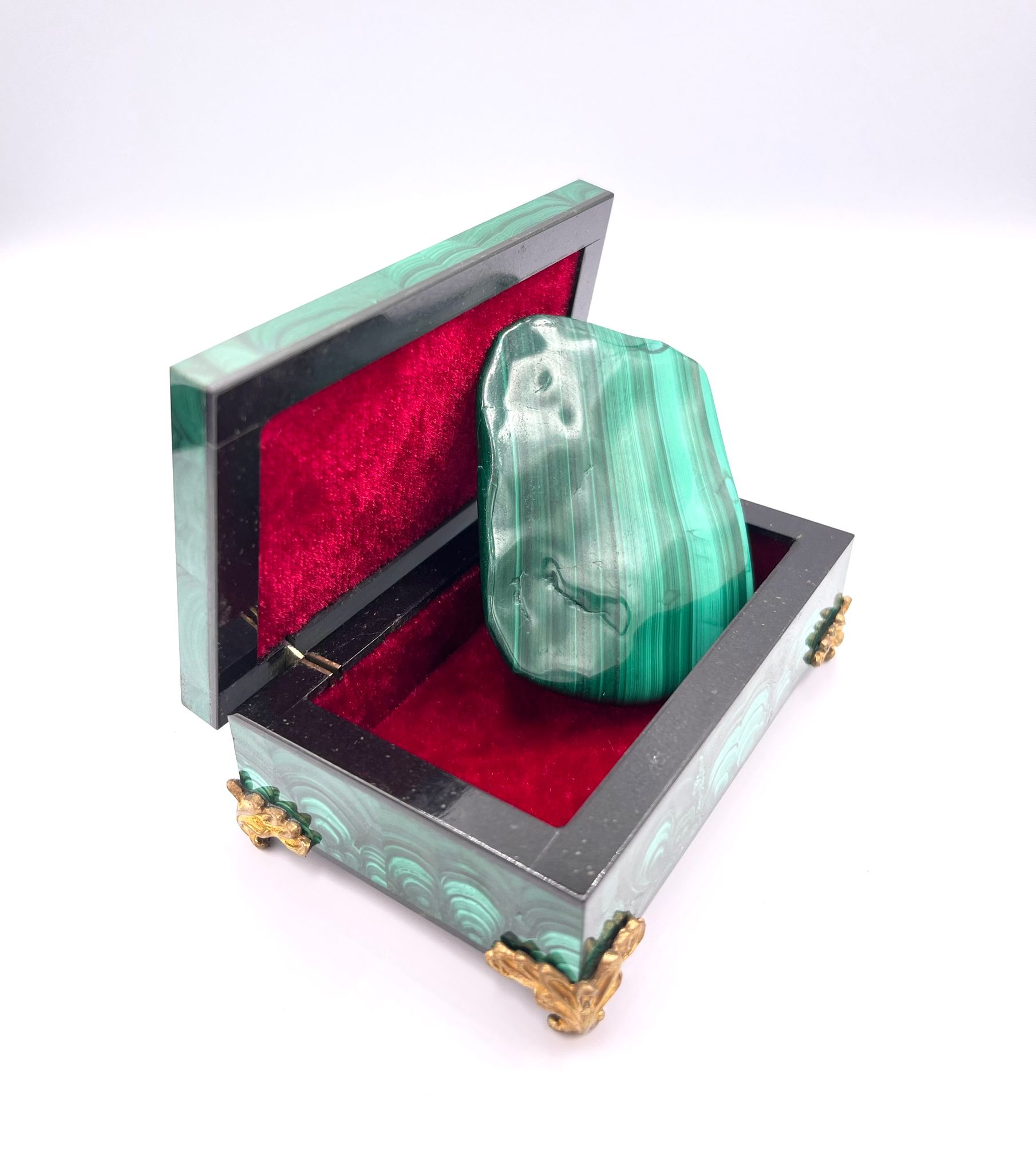 |
| A unique malachite jewellery box and a slice of malachite showing rather straight light and dark green bands. |
One of the many members of the feldspar group, amazonite perhaps is the most popular non-phenomenal feldspar variety. Named after the Amazon forest where it was first discovered, it appears turquoise-like with a little more green than blue. On top of the colour, it has its white distinctive grid-like mottlings, just imagine the marbling of an A5 wagyu beef. It can be polished, cabbed, carved, or even collected as a mineral specimen whereby Colorado has some of the finest amazonite with smoky quartz specimens in the world.
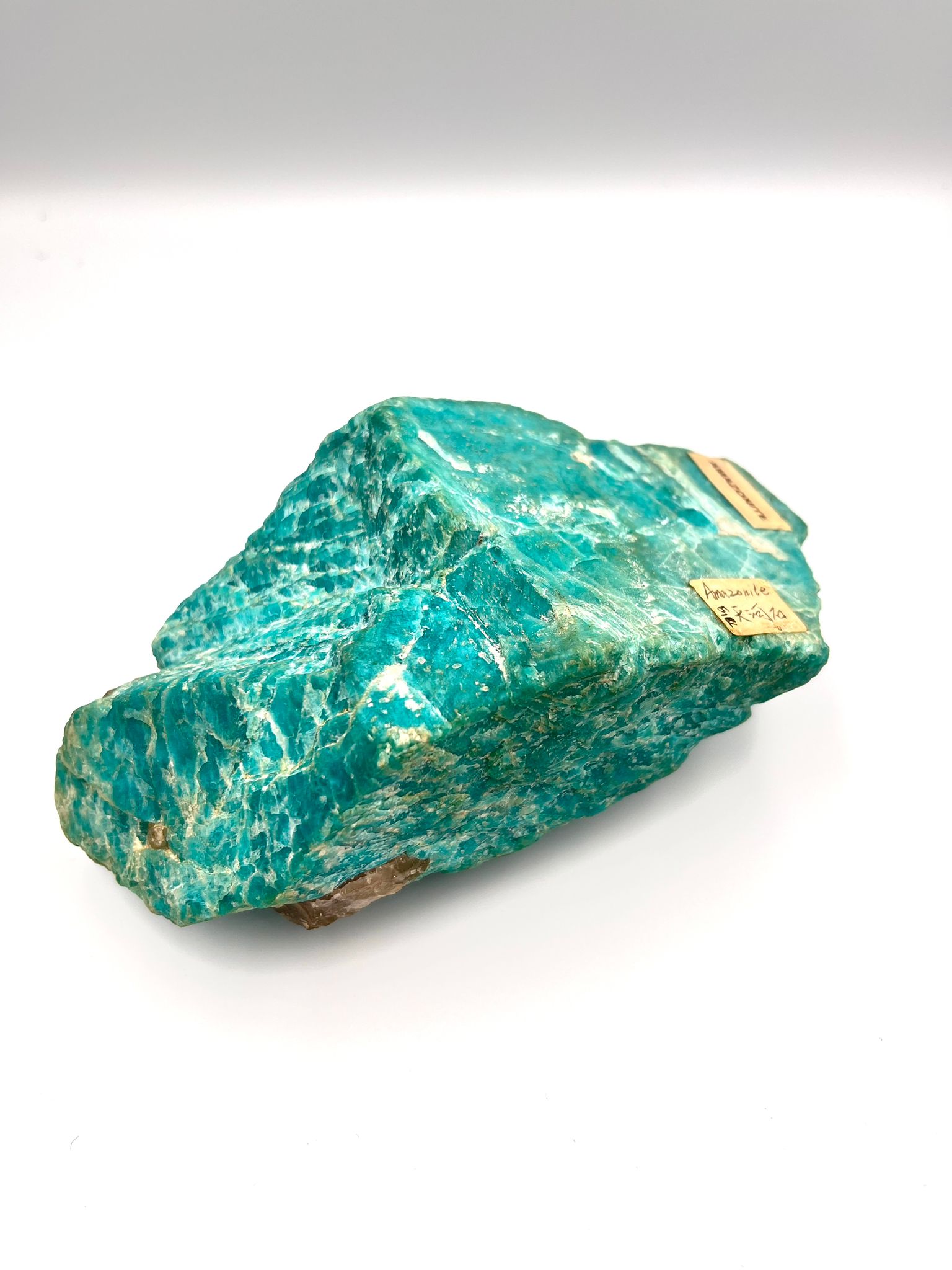 |
|
A large piece of amazonite showing lamellar twinning. |
One thing is for sure, pure green diamonds are extremely rare. Similar to zircon, radiation is the cause of green in diamonds, just without the radioactive elements present within. As mentioned, pure green is rare because usually it has modifiers like yellow, brown, or grey which makes the colour a little too complicated. The largest known for this coloured diamond is the “Dresden Green” diamond, weighing at 41 carats and was discovered in the early 1700s. An on-going dispute with radiated-coloured stone is that it is almost impossible to tell whether the radiation is naturally occuring in the soil or being exposed in a laboratory. Fortunately for the “Dresden”, radioactive technology was yet to be developed so it is confirmed that its colour is naturally obtained.
|
|
|
|
Although pure green diamonds are rare and often irradiate to get the colour, we may find some unusual green diamonds, where its colour is certified to have a range of secondary colours. This is a Dark Grey Yellowish Green 1.00ct SI2 diamond that is also known as “Chameleon” diamonds in the trade. This is considered to be a green diamond, as its primary colour is stated as “Green”. |
A 0.46ct Fancy Greyish Yellowish Green SI1 chameleon diamond that changes colour temporarily either under heat or the lack of light. |
|
|
|
Sphene is rather uncommon as a gemstone, and when they do, they will be a collector’s gem. It is a titanium-rich mineral, regularly seen in a yellowish-green colour, and it has a few unusual optical properties. Once fashioned into a faceted stone, it is able to display trichroism, which is the ability to showcase three different colours when viewed from three different axis directions. Also, it has a high birefringence, resulting in transmitting light to split into two rays and thus a fuzzy appearance. Last but not least, it has a dispersion rate exceeding even to the diamond. Depict all the olive green body colour and see rainbows discoing inside the stone.
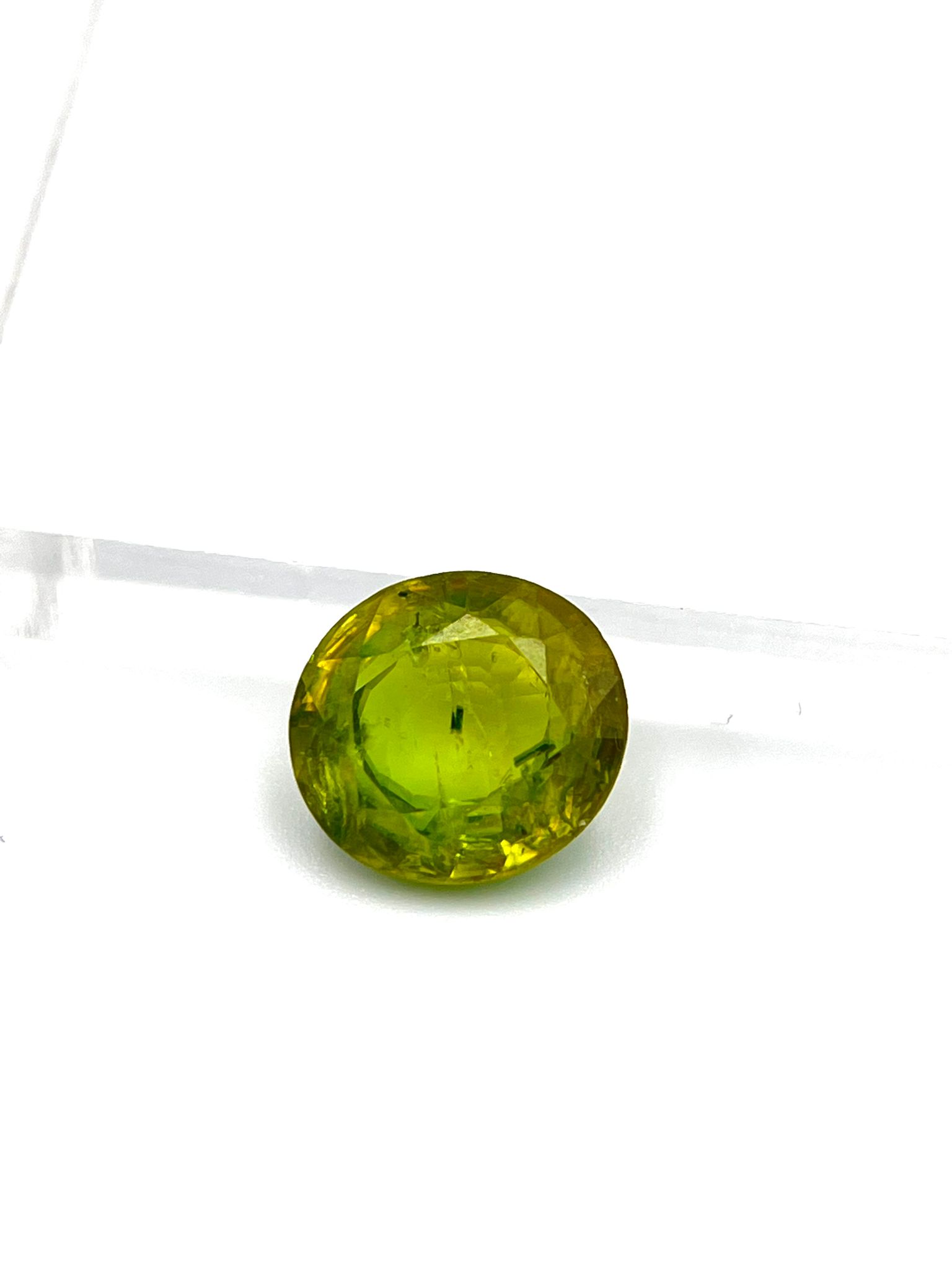 |
| A 2.73ct sphene |
Though rarely transparent, prehnite is a translucent mineral known for its silky colour of green or olive green, and widely used as a jade simulant for their similarities in appearance. Mostly fashioned into cabochons and it is also excellent for carvings.
 |
|
A prehnite carving of birds from China. |
Fluorite may not be the best material for jewellery due to its fragility, it mainly has been collected as a mineral specimen. Forms in the isometric crystal system and often displays a cubic crystal habit, at times with dramatic colour zonings. Different origins of fluorite may consist of different traces of impurities, leading to its wide range of colour, green however is one of the common colours seen in fluorite. What makes fluorite unique is its ability to fluoresce. Fluorescence was in fact named after some studies were done on this mineral, and most green fluorite turns purple or sometimes blue when shone under UV light.
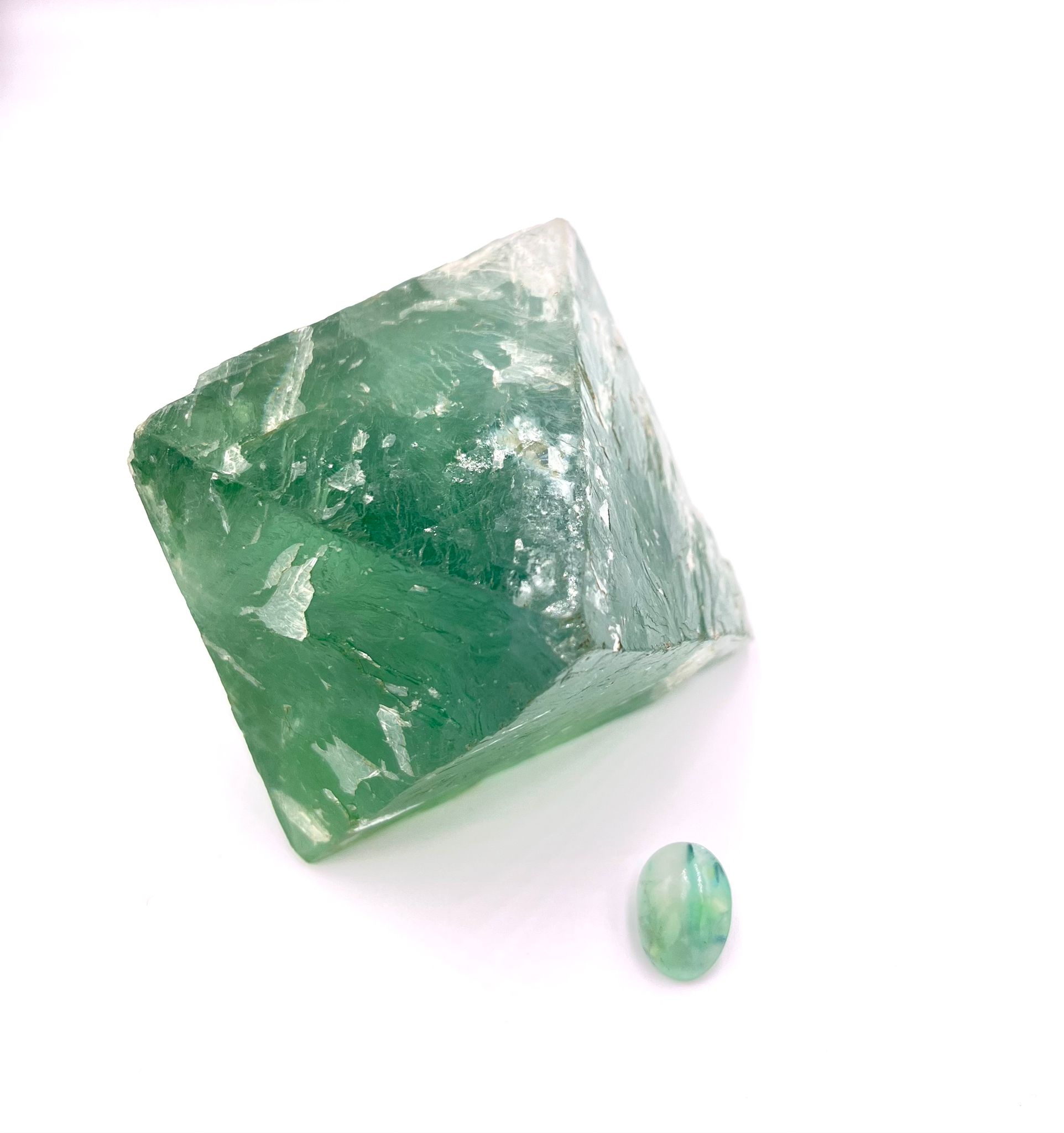 |
| Fluorites are generally soft, with directional cleavages and may be hard to facet. Most polished fluorites maybe found as cabochons. |
Much unknown to the public due its rarity or rather almost zero demand from its lack of marketing. The reason for the latter essentially a result of kornerupine’s somber and sad green colouration. Albeit its disadvantages, kornerupine can have chatoyancy, also known as cat’s eye, which makes it phenomenal. In extremely rare cases, an asterism or star can be observed. Now it mainly serves as a gemstone connoisseur’s interest.
 |
| A 0.50ct Kornerupine |
Similar to the kornerupine, diopside gemstone does not hold a present in the market. Rather, diopside is better known for its asterism which is typically dark brown in colour due to its inclusions. Transparent green diopside is typically deep in colour caused by chromium. Whenever it is deep green in colour, it will be called chrome diopside.
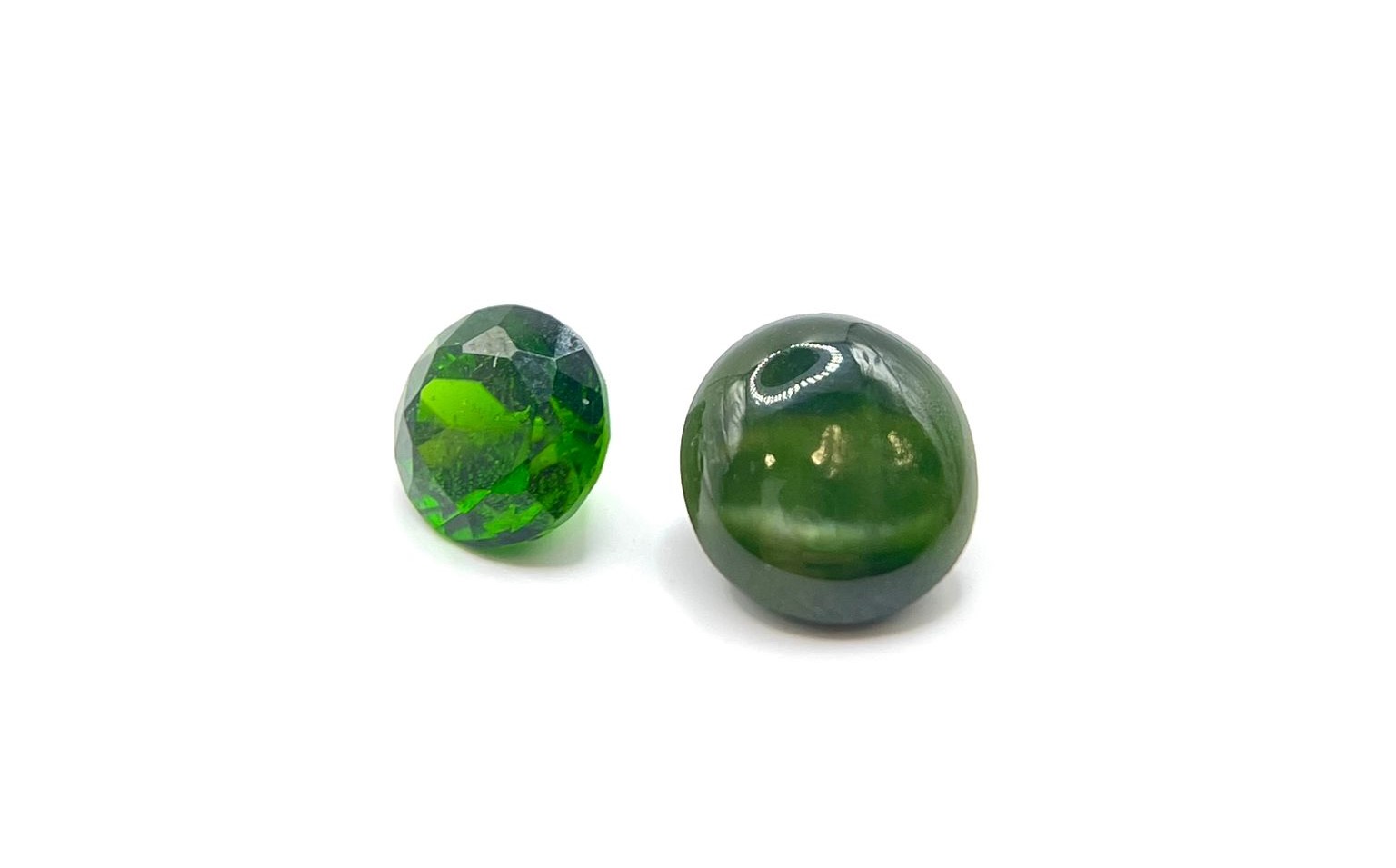 |
|
Left: A 1.60ct faceted diopside. Right: A 2.34ct cat’s eye diopside. |
Another collector’s gem, hiddenite perhaps is the lesser known green spodumene variety behind kunzite - a pink-purple spodumene variety. Generally spodumene has a relatively good hardness, and hiddenite displays a lovely medium-toned green colouration, similar to a light-toned emerald or a mint tourmaline. One may wonder why such a beautiful specimen rarely enters the market, mainly due to an unfortunate fact about spodumene - they are heat sensitive. Those lovely colours can fade over time when exposed to direct sunlight and therefore diminished their suitability as gemstones.
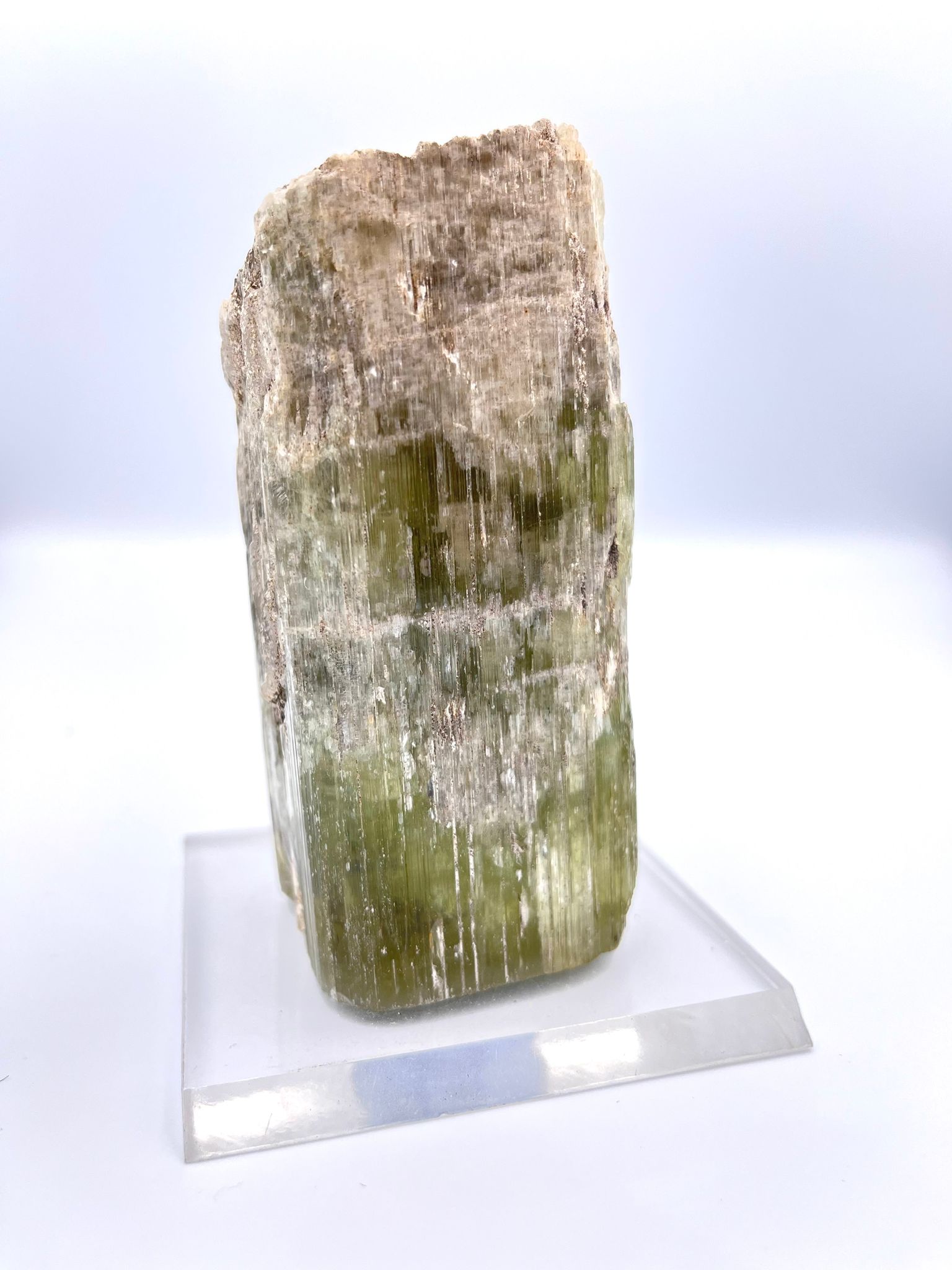 |
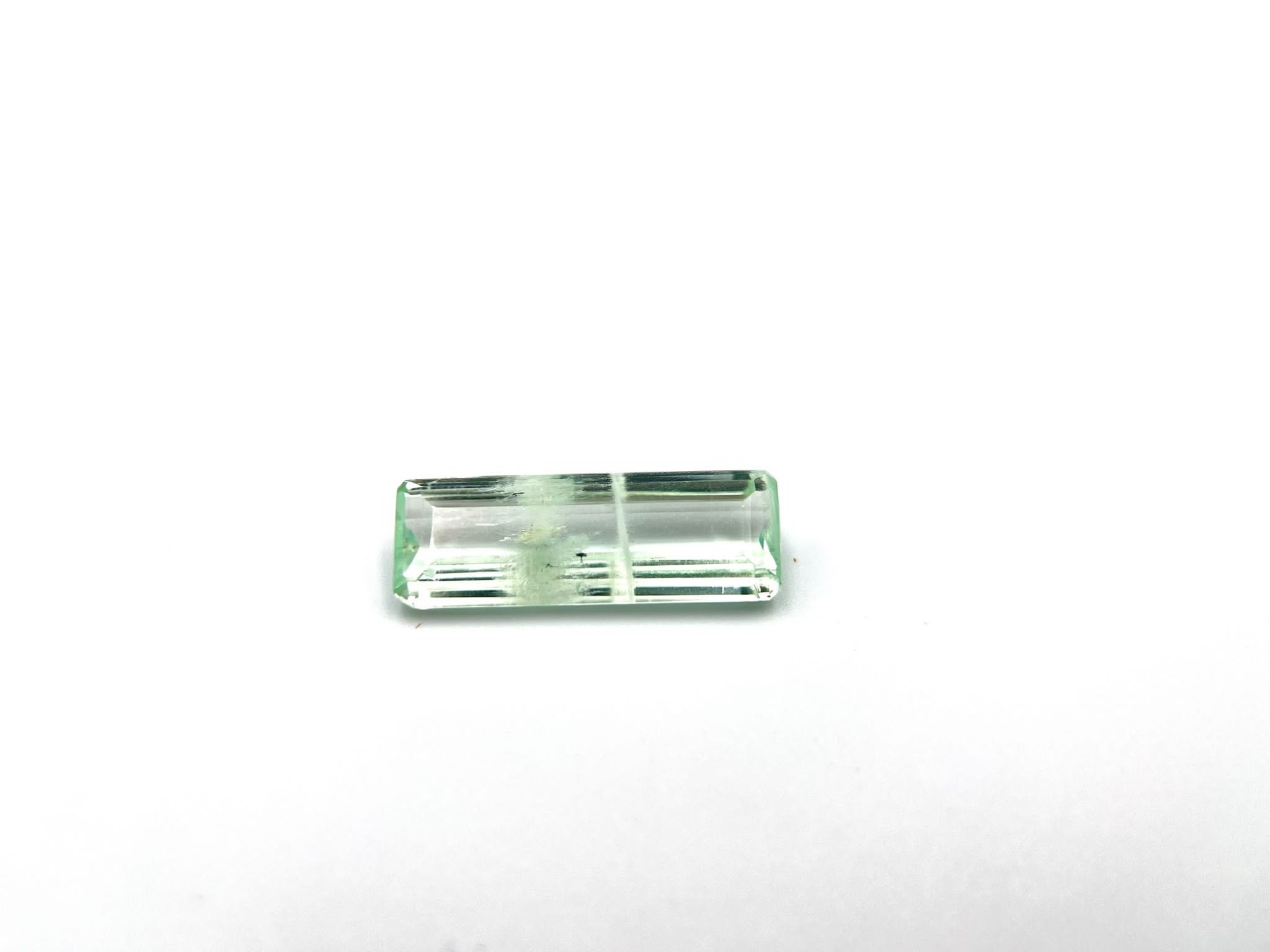 |
| A large rough hiddenite from Afghanistan. | A very clear emerald cut light green colour hiddenite |

